#I can see that in every Voltron iteration
Text
I've been seeing more and more people recently compare the current Good Omens/Our Flag Means Death/What We Do in the Shadows fandoms to the build up from the Superwholock days. and let me tell you, as someone who was just getting into fandom during the height Superwholock but was observing from outside those fandoms, i definitely see it.
similar amount of crossover within the fandom, similar types of crossposting. similar formats of engagement (response gifs, edits, and metas regularly breaching containment and being seen and engaged with by people outside the fandom) and similar intensity of theorizing and analysis. similar desire for comments and responses from writers and actors involved. I can even point out how they are analogous to each other as crossover fandoms.
good omens is the most obvious . it has the angels and demons and religious/mythological imagery of supernatural as well as the fandom engagement and irl stanning with the creators. it shares David tennant and several actors with doctor who. and you cannot look me in my face and honestly tell me that coffee theory and the similar theories don't have tjlc vibes and that the way we talk about and engage with Neil gaiman doesn't have the vibes of how sherlock fans engaged with Steven moffat and Mark gatiss if they weren't massively weird cunts to his fans and kind of homophobic.
our flag means death involves fictionalized and revised history as well as having several stories/arcs that feel like they are coming from different genres but that still fit together like doctor who. it also has the giffability and similar types of analysis for characters and relationships. it has both the capacity for mundane lines delivered so uniquely that they become deeply quotable like doctor who and lines that are so absurd that they are imminently quotable like Sherlock.
What We Do in the Shadows has the long running with a few different iterations thing that doctor who has. to a lesser degree, but still. it has the absurd dialogue and situations that Sherlock had but without the distain for its fans or weird homophobic subtext and queerbaiting. it has the wide representation of mythological and folkloric creatures and stories and consistent random out of context lore notes that supernatural had.
the most entertaining part of this is how deep we all seem to be falling into this. the depth of this crossover fandom hole definitely seems to go as deep as superwholock. I mean I've seen several friend groups that have a similar breakdown to what is going on in my house right now which is
me: has been a Tumblr kid since before the height of superwholock, escaped the curse of supernatural
roommate 1: was a supernatural fan on the Internet during the height of superwholock, escaped the curse of tumblr
roommate 3: was neither a supernatural nor a Tumblr kid but was in the Voltron Instagram fandom and has read more fanfic in total than the rest of us combined
roommate 3: has been busy playing Minecraft and Lego star wars the whole time all that mess was happening. knows nothing about fandom.
all of us right now: losing our collective shit about gay angels and pirates and vampires. at least one person in this house cries about them daily. there is at least one tortured wail echoing down the hall when someone gets a sad edit on their fyp/feed every day. we have regular in depth discussions of characters and head canons and different interpretations. we bribe each other to trade chores or do favors or let us win games by offering one shots of the other person's preference.
and I haven't seen this many people go this feral in this way since superwholock died down. and I'm having fun actually participating this time around
#our flag means death#ofmd#good omens#what we do in the shadows#wwdits#fandom#supernatural#doctor who#Sherlock#superwholock#our shadows mean omens
50 notes
·
View notes
Note
What was Lotor’s relationship with his father like? He seems to be very set on there being a difference between Zarkon and who was his father. What is that difference? Lotor obviously revered his mother a lot, did he feel the same towards his dad or were their differences always a point of divide between them?
Love little blade sm!! I think I’ll be 30 and still waiting for updates (ouch didn’t mean to be backhanded with that. It works anyways)
Okay so I shan't go into //great// detail with this one, because Lotor's relationship with his father is very much crucial to the narrative in that it has a subconscious impact on,,, pretty much everything he does. That conversation—some iteration of which may occur sooner than you think—is one I have dwelled upon e x t e n s i v e l y but what I can tell you for now is this:
When Lotor briefly touches upon his childhood in chapter 12, he speaks of that particular point in time when he and his mother were both frail (Lotor due to his dual lineage, Honerva due to having barely survived being pregnant with a galra child, and the both of them as a result of having spent so much time in such close proximity to such vast quantities of raw quintessence) and Alfor begged Zarkon to close the rift, because the dangers of meddling with what they didn't fully understand were becoming apparent. The issue being, of course, that the rift held the answers to curing Lotor, and so neither of his parents were willing to simply let him die, Alfor be damned.
“He told me what had happened, told me of Alfor’s concerns, and then told me that if the whole damn universe had to burn for my sake, and the sake of my mother, then he’d set each and every planet aflame with his own hand.”
- Little Blade, chapter 12
This bit in particular illustrates the very beginnings of Zarkon's corruption, and isn't that sad? Because, yes, there's an undercurrent of violence there that we see tenfold in the present-day, but in this moment it stems from nothing less than love.
“He loved you,” Keith hears himself say, and can hardly reconcile this image of Zarkon as a devoted father, with the tyrant he’s become.
“Yes,” Lotor agrees, softly, “he did. He loved me, and he loved my mother, and the entire universe paid the price.”
There isn’t anything Keith can say to that.
- Little Blade, chapter 12
As a child, Lotor knew a Zarkon who was devoted beyond compare to his Empire and his family both; a Zarkon who loved his wife and child and was desperate to do right by them; a Zarkon who would have done anything—everything—to ensure the safety of those he held most dear (and ultimately, to his own detriment, did exactly that).
The creature that returned from the rift wearing his father's face was not that man.
And it's not even just Lotor! We see the same dissonance between who Zarkon once was and who he now is presented (though indirectly) by Allura.
She doesn’t breathe a word of Zarkon.
She doesn’t, but Keith hears it regardless, because there are gaping holes in the stories of Allura’s childhood that can only be filled by a great shadow—one that is powerful and disciplined and her uncle by everything but blood. Somehow, Keith never thought to connect Zarkon’s past as Alfor’s dearest friend to Allura in any way.
It seems like an obvious oversight.
- Little Blade, chapter 15
Because once upon a time, long before he was warped into an immortal monster, Emperor Zarkon was....just a man, and a good one at that. A paladin of Voltron, and everything that represents.
#was I prepared for Sad Zarkon Hours™ you ask? why no.. no i was not.#a n y w a y#at this rate I think I'll be 30 and still //writing// it - so I'll take that in the spirit it was intended ;)#i will remind you / inform any newcomers that LB was originally intended to be 4 chapters and like.. 20k words MAXIMUM#AHAHAHAHAHA#i was a blind pitiable fool#Ao3 Little Blade#sa screams back#prince lotor
30 notes
·
View notes
Text
Keith: Okay guys, good look out there, and make sure not to get killed.
Lance: We can't really promise that.
Keith: Fine, then perish.
#source: me#votlron#I can see that in every Voltron iteration#vld#voltron legendary defender#dotu#voltron dotu#voltron defender of the universe#80s voltron#vf#vforce11#voltron force#vf11#voltron comics
8 notes
·
View notes
Text
TLOVM Ep 9 Twitch Watch Party Summary
- Tried to make that guy with the Briarwoods look like Brian Foster
- Delilah wanted to save Sylas cause she didn't want to enter the dating pool again
- Arthur hand painted the skull book animation frame by frame!
- Long hair Sylas is SO hot, and she gives him a haircut every morning (cause vampire? I guess?)
- Joaquim Dos Santos did some work on TLOVM as a pat on the shoulder for Arthur and some other animators for working under him in Voltron
- Sam: "Hey it's my daughter!" at the sun tree dead Pike kid (omg...)
- Character design team made a ton of zombie designs so you're not looking at the same ones and there's some 3D ones in the back too
- Liam's line delivery is always SO good (at Vax's "Gross!")
- We went through many iterations of what Scanlan's bite looks like and it's very gross and it gets worse as it goes
- The growling giants are Liam!
- Sam immersed himself with an accent coach for 6 weeks for Scanlan's 'french' accent (he's joking)
- We had a scene cut for time constraints that was explaining why no one could leave Whitestone (because of the demon dogs)
- Arthur's wife screamed watching Archie die haha :(
- (Everyone lol'd at "yes yes she's the tits")
- You can really see the love from everybody in every frame, the whole crew really loves working on this
- Travis and Marisha: He said the thing! (about Percy's name)
- Taliesin crushed Percy's speech, he did it twice cause that's what you're supposed to do but he just did such a good job from the first time
- "Don't drop that shit on me now, I can't process this!" Marisha about Keyleth when Vax confesses to her
- (Everyone cheers when Pike comes down all glowy and shit)
- Ashley really wanted to say a very goofy "HULLO!" when Pike beamed down during the zombie fight but they went with something else (lol)
- The sound design is amazing!!
- (They're cute and just cheering throughout the zombie and giant fight anytime anything happens)
- Rory (The Hound) saying "ballbag" when Vedmire kicks it was so funny, Dominic (Monaghan) had said "dobber" which apparently is a very thick penis lol
- Vedmire's hung corpse really brings the room together
- "This is the dungeon, Keyleth" (they laughed about it but idk just wanted to mention it again cause it made me laugh)
- This is Percy level 2 or 3? Nope, it's critical mass Percy
Q&A
Q: Tell us about the art teams' blood, sweat and tears with the zombie apocalypse?
A: All the art teams did a really good job, everyone came together to make it look that good. There was a lot that went in there to make it feel organic and real, like staggered gait, and different looks and personalities.
*We watch the Pike's Return Animatic*
Q: How did the scene change than from the game?
A: We made it extra since it's animated, you know, she came out of the sky and gave everyone the equivalent of Holy Weapon
Q: Giant designs are great, let's talk about them.
A: Everything was really well done, and how they look refers to who they were before they died like: the muscle and sinew under the skin, different levels of decay, barrel as a pauldron, and the different clothes and beards

Q: Vax finally tells Keyleth how he feels, how was it distilling that moment for the animated series?
A: Super wise, but charisma is her dump stat. When it happened in the game Marisha asked Laura: "What?? How long has this been going on?" Laura: "For like fucking 40 episodes." Liam had been doing all these little things for ages like 'Vax sits next to Keyleth' and I was just like "Ok cool!" (Travis: On the show when this happened, we all escaped into our shirts like 'WHAT IS HAPPENING?') Liam trailblazed character romance in our games (Ashley: I didn't know you could do that!) It was important to not rush it here, because in the original game they had like 40 episodes of lead up and a lot of time for the romance to blossom realistically, but here there's less time so you have to be intentional about it. But I (Marisha) like how we subverted the romance trope with Keyleth, she wasn't like "OH my prince!" she's more like "Not now! this is NOT appropriate!" (lol cute)
Q: Speaking of romances: Pike and Scanlan, what the fuck?
A: Sam: I think we're destined to be together, Ashley: but it's gonna take Pike some time to make her way (all: makin' my way) they're long game so it takes a while. Sam: Scanlan has always thought he's a skilled romanticist but he actually cares about Pike but he doesn't know what to do about that, it's easy to hook up with someone but it's hard to get someone to care about you
Q: Arthur, any artists or references that influenced the show?
A: Oh crap, maybe 3 years ago. But I took the last show I worked on with me, including artists and background designers (from Voltron: Legendary Defender) and we had fun with it
Q: Favorite game to show moment so far?
Travis: Dark spirits coming after VM, desmond wasn't there but it was great to lock in on those character beats and different faces of their personalities - big action moment though? Pike's return
Marisha: The sun tree was like "What the fuck is Matt thinking? Holy shit" so was great to see that translated
Ashley: Pike's return and the sun tree moment, and just in general and seeing Gilmore for the first time - it was glorious
Sam: Seeing Scanlan up on the roof amidst rain and flame, it was improv'd on the spot and now it's something that fans can watch and enjoy on their screens - "You know I love you" moment, it's cool that it's different from the game, I always pushed to change moments just a little bit, cause we have the game and we can go watch it again, so it's fun to try new things out
Arthur: Gilmore's shop, getting to flesh that out was really fun, we really went nuts, we shouldn't have gone that detailed, it's crazy - but number 1 moment hasn't come out yet and you'll see it soon!!
(In honor of Arthur's nuptials, they bring out champagne! And they toast for them but also for all the designers and artists and animators and their amazing work. Very cute.)
#tlovm#tlovm watch party#cr spoilers#the legend of vox machina#critical role#vaxleth#pikelan#cr#glossopost#long post
256 notes
·
View notes
Text
Hi, @pilotkinkade! No worries about a delay—real life and school are way more important than critical analysis of a cartoon, lol. I’m thankful you got back to me, though. I appreciate your response posted here—and no, it didn’t feel patronizing at all! I can see what you mean about things.
In terms of Wikipedia’s definition of white savior as a cinematic trope, I can see where that could be applied to the entirety of the VLD show as you mention, even in aspects to the Balmeran episode. In VLD, I do see how in every case, the largely unprepared MCs save a group of people and in doing so, usually learn something about themselves/achieve a power unlock that makes them personally stronger, especially compared to the people they assist/save, who remain without such power-ups. Or, in various other instances, Team Voltron is shown as “more enlightened” in ethics or willpower, etc. compared to the people groups they’re trying to save/convince to join their cause. That concern absolutely does make sense, and it’s definitely a problem that our paladins are placed on that kind of pedestal and that it’s...celebrated?
I also felt this line of yours in my soul, lol: “i think this is an issue with voltron: liberating a country, let alone a whole planet, is a long, tiring, bloody process. i guess voltron by its nature circumnavigates that, but. it is, to say the least, frustrating to watch.”
Yeahhh lol, I think in terms of how it handles war and heavy situations, VLD accepts a lot of “this isn’t realistic war/politics” moments by virtue of it being a Y7 cartoon? Its fantasy violence is targeted for, I guess, 7-year-old American boys... So, I think when we sensed those more adult themes and moments of realism, we wanted the show to naturally follow up on those struggles more, but I remember an interview where the dev team talked about having to cut politics because the stakeholders felt it was too adult for the target audience, RIP.
But just thinking about this larger conversation about the unsettling images and implications of VLD Voltron’s power as savior…I keep wondering if “savior complex” is in some way inherent to the franchise as a whole by virtue of how it was fitted to a young American audience back in 1984? Like, not only did the original pilots from 1981’s Beast King GoLion get white-washed for an American audience, but it seems like the whole story structure got some pretty major adjustments, and some characters got altered for better (I’d argue 1984 did humanize Lotor and other antagonistic aliens) or worse in various ways (the Voltron pilots became “foreigners” to the war they grew to fight in as the most powerful warriors, instead of the GoLion storyline of the pilots being a band of escaped slaves)…And that’s all on top of the original story being rated much higher at TV-14, while Voltron: Defender of the Universe 1984 was sanitized to Y7.
I wonder if these decisions in 1984 feed into the tangles and weird power structures/savior narrative we see in VLD?
I feel like the only Voltron iteration that really reflects on and questions the “powerful savior” narrative is the one that was rated for older audiences (16+), which is the Dynamite Comics (2011), written by Brandon Thomas...
It was perhaps one of the most innovative versions of Voltron, even though its artwork is criticized for its quality. I say innovative because Team Voltron actually recognizes that they and their machine have been fighting in the name of a corrupted Earth just interested in further conquest and corporate control of its own, and that Earth is actually no better than Zarkon or other despots. It’s a really sticky mess. So we really see Team Voltron try to disavow themselves from that past and their leaders, at the same time that the team and Drule Empire both are realizing that a far darker force (sentient rift creatures, basically) has been instigating the entire war across the universe, using Voltrons to carry out its will, and poisoning people against each other. In this iteration, team Voltron is not the most powerful, nor are they even the only Voltron. And anyone in this iteration could learn powerful magic. So it’s a really complex backstory that tries to unite long-standing opposing groups together under fairly equal powers. And while it’s clearly still got some problems, I really appreciate what writer Brandon Thomas was trying to do here. It feels like a critique on DotU 1984’s mentality around Voltron, while also reaching back to Voltron’s 1981 Beast King GoLion origins—in which, in that version, the pilots were actively victims of the war and had intense, personal reasons for further involving themselves to stop Zarkon.
VLD seems to lift a lot of plot points from the previous Dynamite Comics, along with GoLion. But in doing so, VLD seems to strip out a lot of involved backstory and the past gray morality of Voltron itself. Which seems to reverse the reboot back to its 1984 “yay we’re here to the save the universe” fluff.
An anon recently joined in on our discussion here to suggest that maybe the trope we’re looking for regarding Allura specifically is called “xenos savior trope”? Which appears to be in reference to the larger genre concept of a foreigner of any kind outside the group being the only one who can actually save the day/that group. So it seems to be related without necessarily taking on some of the criteria I suppose I apply to white savior complex specifically….
About Allura’s sort of “Chosen One” hyper-abilities even as an Altean… You’re right that the show isn’t terribly explicit about it. Episode 1 prefaces some of Allura’s powers by referencing that they exist because her life force is tied to Voltron. I talk about it in an old meta here if you’re interested. (I also have this other meta too, where I try to argue that seasons 1-5 have details suggesting Alteans aren’t inherently a master race, but that world-building contradicts the latter half of the show which hinges on that master race concept. But the meta itself also gets into the screenshots about Allura’s life-force tie and her abilities vs. Alfor’s.)
Ultimately, the show certainly doesn’t take time after episode 1 to reiterate why Allura would be so special, but her tie to Voltron is the only thing I can think of for why she’s on such a different level even from Honerva or Alfor, both of whom also made it to Oriande.
I keep thinking about what it would mean to fully update VLD for modern audiences, and I wonder how things would have felt if every major race involved in the war’s scope were still represented by the paladins (reflecting the s3 OG paladin diversity, which did feel really cool). And if everyone had magical abilities but simply that different cultures had different understandings or uses of it—but that they weren’t inherently incapable of learning another’s way. I wonder how much that would have changed VLD as a show…
#Voltron#Voltron meta#Voltron critical#Allura#Alfor#VLD#DDP#Voltron Dynamite Comics#this is a really interesting discussion and thank you for continuing it with me#Lots of complex issues all happening at once
16 notes
·
View notes
Text
Every Boros Commander, Part 2
Where we last left off, I was shitting on Adriana, Captain of the Guard, who gives ACAB a pretty different meaning. Fortunately, most of the pickings this time aren’t quite as dire.

Depala, Pilot Exemplar (3rd most played as of writing)
Holy shit, a Boros commander with card advantage? It’s niche, but it was a first. Being limited to Dwarves and Vehicles does leave her with a problem a lot of commanders and tribes tend to have, which is being just a smidge under critical mass- but with the upcoming Kaldheim appearing to support Dwarves, and vehicles appearing to be a deciduous mechanic, I feel like it won’t be long before Depala is as powerful as her placement suggests. She is niche and mana-hungry, but basically the only Vehicle commander (and definitely the only Dwarf commander at the moment), so I suspect she’s here to stay for a while.

Tiana, Ship’s Caretaker (15th most played as of writing)
Tiana is possibly my favourite character lorewise in all of magic, frankly. She’s cool and cute and a massive dork and also someone who found her purpose in life, and frankly I love that for her.
She’s also a really interesting commander to build around, seeing as she has a unique brand of card advantage that leads to the addition of old and weird cards, which I’m always a fan of. I should really get around to building a Tiana deck, to be honest, though I already have 10 commander decks with an 11th in progress, sooooo…

Firesong and Sunspeaker (4th most played as of writing)
I’m surprised to see F&S this high, but the first unique Buy-a-Box card did expand into an archetype previously unseen in the combination in the form of Boros Spellslinger (Dalakos would later return the favour as an Izzet Equipment commander). Previously, you had to go into Pauper EDH and play fellow Minotaur Blaze Commando for this kinda deck. Like Depala, F&S are heavily played despite being niche, though the also have the benefit of being a RW minotaur commander, if you want to play White instead of Black in that deck for…some reason? The siren moo of Boros Reckoner speaks to us all, I suppose.


Sylvia Brightspear and Khorvath Brightflame (17th most played as of writing)
The only partner pair I’m discussing today on account of their monogamy. Knights and Dragons make a weird combination, seeing as there are basically no other cards that help them work together rather than apart. You could almost run them as a goodstuff deck if you wanted, seeing as many of Boros’s best creatures are Knights or Dragons, but largely I think sticking to one or the other is probably for the best. With that in mind, the pair are actually the only real commanders for either tribe within Boros- the only other Dragon is something we’ll get to, and the only knight is…Adriana…so…. The buffs given by either pair are excellent, and not something that either tribe gets easy access to typically, so I can see the appeal of them in that slot. At that point, the extra commander is just a bonus.

Aurelia, Exemplar of Justice (21st most played as of writing)
Oh, another Aurelia, and she’s worse this time. In seriousness, her ability looks like its likely to be targeting herself most of the time, and Mentor just doesn’t do enough in this format. She has enough keywords and power to Voltron, but I’m not expecting much interesting from her outside of that.

Tajic, Legion’s Edge (18th most played as of writing)
Tajic has 4 separate lines of text for some reason, and only one (ok fine two haste is nice) actually matters. Having a damage prevention effect is nice in the zone, but it doesn’t apply to himself, so if you’re planning on turning mass damage one-sided you’re going to need to protect him still. And like, what else does he do? He’s not a good aggro commander at all, his last ability is a joke, why are people playing this card? If I was in a mass damage deck I’d just play Gisela, at least she does something on the off chance she survives. Probably no-one is gonna go out of the way to kill Tajic, at least. Beats out Aurelia for biggest downgrade, imo, even if Aurelia fell from higher.
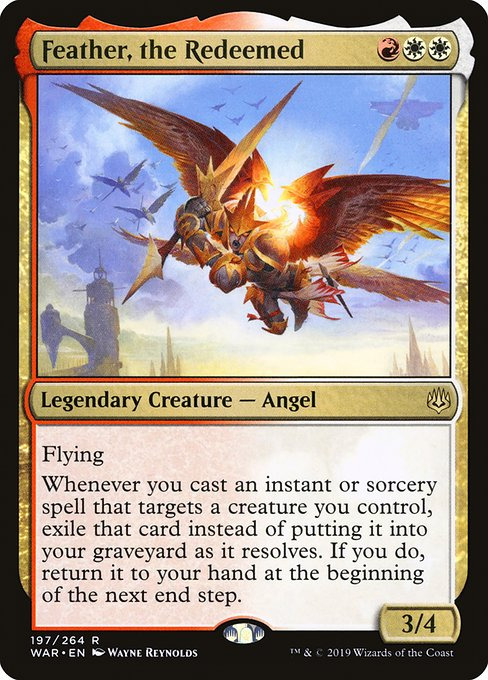
Feather, the Redeemed (Number 1 most played at time of writing)
Feather is the most popular Boros commander, by over triple the next most popular. It’s not hard to see why: she’s a cheap commander that turns any targeted cantrip into a draw engine, she synergises with so many random powerful cards that you can build her a fair few different ways, and she’s a cool story character getting a card 12ish years after her appearance in the Ravnica novels. She does so much and is so interesting that it’s completely understandable that she’s as huge as she is. I’m still never going to build her though, even with my funky Japanese copies, if only because I’m too much of a hipster.
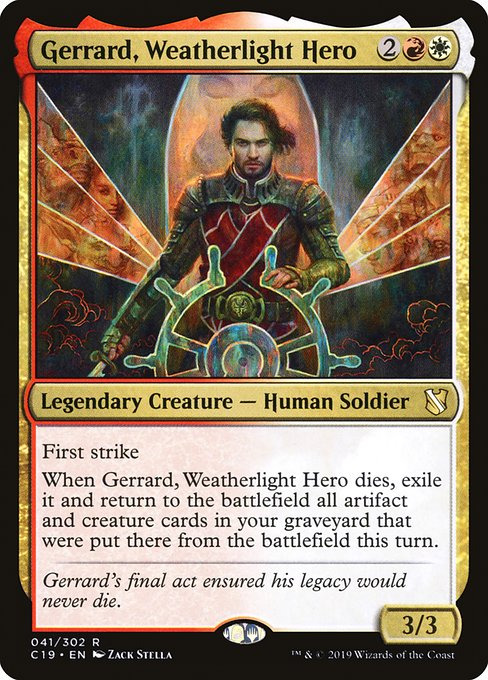
Gerrard, Weatherlight Hero (13th most played as of writing)
Kinda funny that Gerrard’s little text that made him work in the command zone until recent rules changes is now a strict downside. Gerrard has his niche, with a Second Sunrise in the zone unsurprisingly supporting Eggs decks rather nicely, and synergising with a lot of just random bullshit. I’d probably never build him, and it seems pretty easy to make it degenerate, but I’m glad he’s here and he’s certainly better than the first iteration of the character.
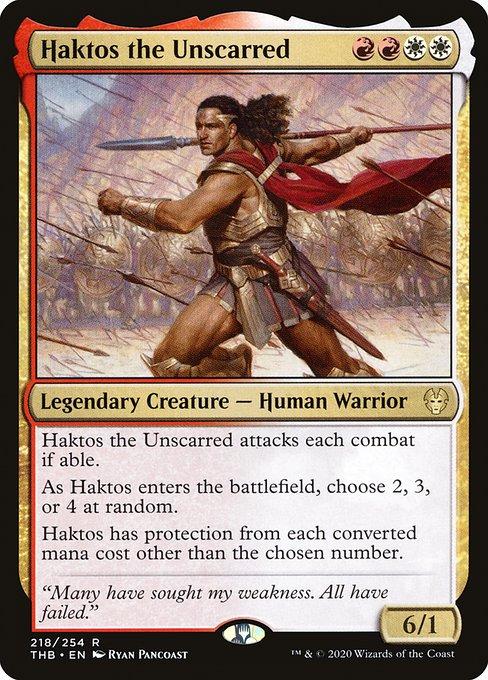
Haktos, the Unscarred (12th most played as of writing)
I’m kinda surprised to see Achilles this high, considering how recent he is. He reminds me a lot of Progenitus, oddly enough, as a commander that would be good at Voltron but can’t get buffed easily by traditional means. I think adding equipment on the off-chance that it fits his heel is a complete mistake, but things like Silverblade Paladin and Exalted cards do exist, so fair play. He’s pretty hard to kill unless you’re boardwiping, and even then damage-based ones probably miss, so I can see the value in that. But that mana cost hurts to look at- hitting 2 mana of 2 different colours on turn 4 was a pain back when I played Trostani, and that was a green deck.

Stet, Draconic Proofreader (No data available)
Okay look, I tried so hard to find a way to abuse this dork’s ability but there’s just no good way to do it. Stet sucks hard enough that even if you are playing with Silver-Bordered cards legal I just don’t know why you’d ever run it. His art is pretty funny, I’ll give it that. We got Alexander bloody Clamilton and Surgeon Commander in the same cycle, keep in mind.
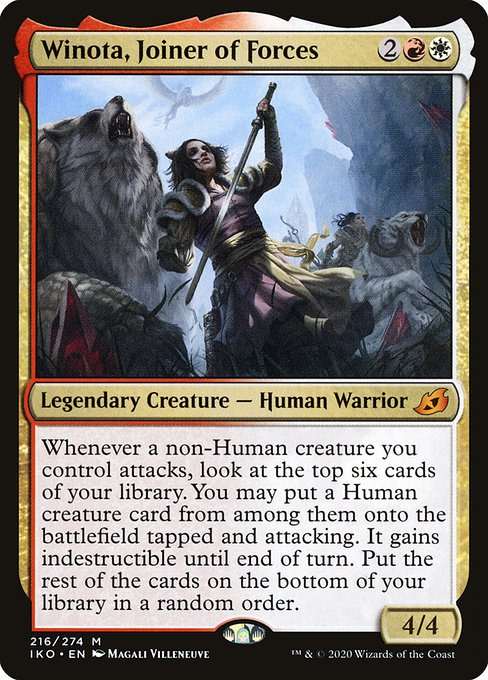
Winota, Joiner of Forces (2nd most played as of writing)
Having menaced standard, Winota is still pretty decent as a commander, even without access to her 7-mana blue payload. There actually aren’t that many beefy humans to cheat out in general, but considering how easy it is to enable her ability and the fact that she digs *6 cards deep* on trigger, I think you just kinda end up swarming the board distressingly easy with her deck. It’s shocking to see a card from 2020 in the top 5 like this, considering how the year has gone for the format in general, but like. 6 cards.

Zirda, the Dawnwaker (8th most played as of writing)
Look it combos with Basalt/Grim monolith in the command zone isn’t that neat. Zirda is pretty open-ended, but not especially powerful outside of the aforementioned combo. I find them much more appealing in the Companion slot, frankly. With that said, I do like that Boros is the colour pair getting access to Training Grounds in the zone, seeing as it works well with its other themes (Equipment mostly) and opens new archetypes (Cycling, etc.) up as possibilities.

Akiri, Fearless Voyager (7th most played as of writing)
Haha, Brion has more decks than Akiri. That’s probably since it only released a few months ago. Of course, I’m not including the other Akiri, so this is the first time we’ve seen her on the list. But apart from that, Akiri was somehow the first of these commanders to actually say “draw” on it. Her synergies with Living Weapon (and the recent equipment cards that do the same) are pretty sick, though her second ability will end up costing a lot of mana over time if you have to use it. I think its hilarious how much more value this gives you than Adriana for doing the thing Adriana wants you to do, at 2 less mana.
Also, she’s probably the best general for Kor tribal? I guess you could go Akiri/Black partner so you can play Orah in the deck. Someone build this! Kor like equipment, Akiri likes equipment, lets go.
It’s only just occurred to me that Akiri gives you more for attacking other players than Adriana does. Fuckin hell, man.
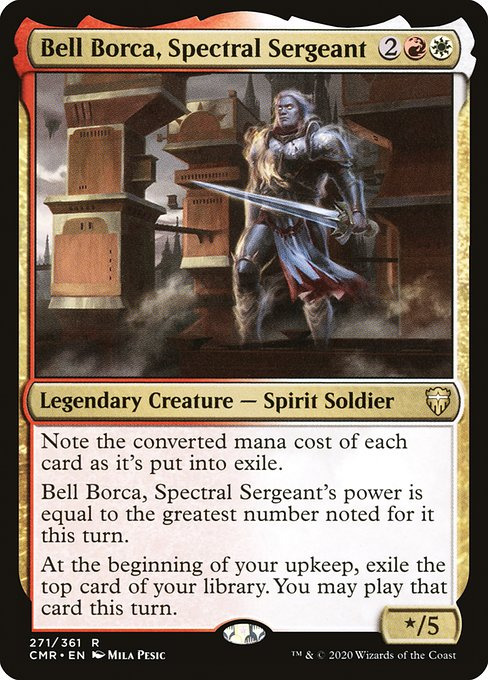
Bell Borca, Spectral Sergeant (25th most played as of writing)
Bell finally getting a card 15 years after his fictional death was a welcome treat, but the exile-related ability is frankly awkward and abusing it to 1 or 2 hit commander damage is pretty difficult. Still, having impulse draw in the zone makes him probably just the best generic #goodstuff commander. I’m surprised he’s as low as he is, but he only released a month ago (at time of writing) and we got an absolute stack of legends (including 2 other Boros ones and the partners) in the same set.
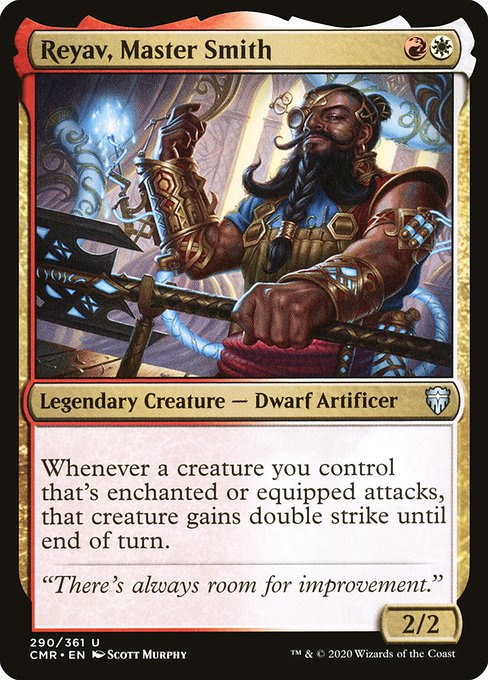
Reyav, Master Smith (28th most played as of writing)
Reyav is neat since he combines 2 of Boros’s more traditional archetypes, being Aggro and Voltron, into one damage doubling dwarf. I suspect his lack of play is again due to the other legends in the same set and that it only dropped a month ago, because there’s no way he deserves to be below Munda. Also, he’s 2 mana! The only other 2CMC Boros Legend is partner Akiri! How did that happen? I think he deserves better. You can suit him up and get dunking real quick.
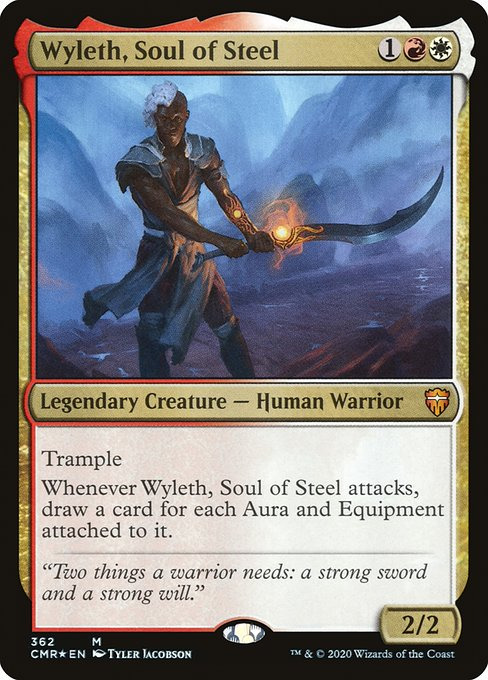
Wyleth, Soul of Steel (16th most played as of writing)
Our final general is Boros’s second ever Precon commander, and the only one with flavour text. He’s got the space for it, considering how much work that second line is doing. I appreciate that Wyleth, despite being superficially similar to Akiri, plays pretty differently, as he prefers Voltron while she prefers spreading equipment out. I assume Wyleth would be a lot higher if the precon itself was included, but there’s no way of knowing how many people are playing just the base deck, so who knows.
A CHALLENGER APPROACHES!!!

Koll, the Forgemaster (no data available)
This bloke got spoiled between me writing most of this and going to publish it. I can see a few easy combos with his first ability, especially seeing as Grafted Wargear is a card. Playing fairly though, his first ability feels kinda slow, and not being able to protect himself is a huge drag. The second ability feels kinda stapled on, as its a way of giving you a bonus since the first one doesn’t do shit for tokens. But like, just don’t equip them, lmao. Awkward, but has potential.
And that’s the lot of them! Uhhhh yeah that’s all I’ve got, stan Tiana kthnxbai
17 notes
·
View notes
Text
The Heroine with a Thousand Faces
As the youngest member of #TeamPurpleLion, not only have I learned a lot in just the four months we’ve been working together, but I’ve explained a lot of what I’ve learned to others. Sometimes it’s about the history of Defender of the Universe and Beast King GoLion that @crystal-rebellion researched, sometimes it’s referencing @felixazrael‘s musical knowhow or @leakinghate‘s animation knowledge, and most recently, it’s leaning on @voltronisruiningmylife‘s expertise in how to break down and identify writing to provide corrections to those who see something in a show or article not working but can’t tell why. One big thing I learned since starting this crazy ride with my team is a massive hole in my college education on writing, which Felix filled in for me since we hit the ground running. Sure in my fantasy literature class we discussed Aesop and The Hobbit, and what the phrase “The Hero’s Journey” means and why it’s the monomyth, but there was one thing that my dear professor never taught us, although I’m sure she will in the future. Compared to Joseph Campbell’s heroic journey, this other monomyth is much younger.
What is it, you may ask?
Simply put, it’s a heroine’s journey.

[Image description: Princess Allura with her hair up and wearing her flightsuit from season 1 “The Rise of Voltron” backlit by white light.]
Let’s go on an adventure together.
To understand the heroine’s journey, I want to give you all a rundown on what exactly the hero’s journey is first. While it was never neatly labeled as “The Hero’s Journey” until Campbell, studies on common themes and plot points began back in the 1870’s. As time moved forward, Campbell published his 17 steps to the monomyth in 1949 (The Hero with a Thousand Faces) and as we move toward the present his monomyth is eventually dubbed as “the hero’s journey”. I won’t overload you with the dates and stuff I needed to study since that’s a) not the point of this piece and b) Campbell’s monomyth is actually secondary to the main one in Voltron: Legendary Defender. That said, it’s the backbone of a lot of literature both old and new, and while not every story follows these 17 steps outlined by Campbell or approaches them in the same order, you’ll find everything from the story of Christ to Lord of the Rings somewhere in these steps. It’s just that a lot of times the steps of the hero’s journey aren’t ever really explained, so you as a reader/viewer/consumer will see them and will have a gut instinct as to what’s supposed to happen, and when it happens you feel great! The story followed a formula that satisfies its audience! But it also makes a story that doesn’t follow a formula feel fundamentally wrong, from just a mild discomfort like putting on a shirt and buttoning it slightly off, all the way to triggering strong emotional responses including panic attacks or tears. Stories are designed to bring forth emotions from their audience, but what good is a tragedy without a lesson to learn? How can we enjoy an empty marriage when the couple has no chemistry?
So with this piece, I hope to illuminate just what the steps of the heroine’s journey are, contrast them against the hero’s journey, where VLD fits into all of this, and through that demonstrate why they are not interchangeable even though they share similar names.
Part I: Of Heroes and Heroines
In The Hero With a Thousand Faces, Joseph Campbell outlines seventeen steps, which are laid out in this diagram by Reg Harris:
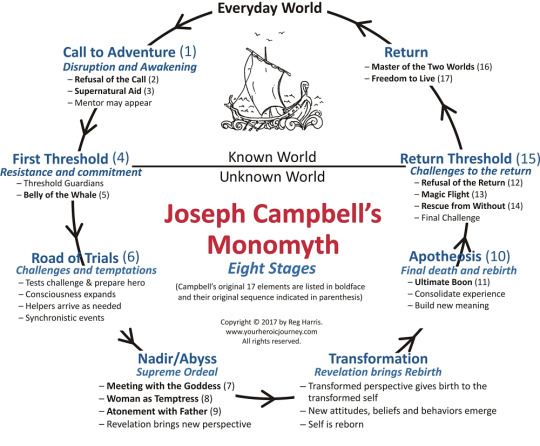
[Image description: diagram of The Hero’s Journey using a circular diagram shape separating out the seventeen steps into eight categories, divided into the Known World and the Unknown World.]
In Maureen Murdock’s The Heroine’s Journey, she writes the heroine’s journey as follows:

[Image description: The Heroine’s Journey depicting a cyclical diagram of the narrative, featuring 10 distinct steps that loop back to the beginning at the top.]
The Heroine’s Journey is fundamentally cyclical in nature, and while the diagram above shows the Hero’s Journey as a circle as well, it ultimately has finite start and end points. One of the key differences between these is that the Hero’s Journey explores internal character in an external adventure and the hero achieves a (theoretically) lasting peace once their journey is finished. Conversely, the heroine must constantly evaluate themselves in the bigoted environment that tries to disenfranchise them.
As a note, while I use gendered terms such as “hero” and “heroine”, I use them as gender-neutral placeholders to label which monomyth I’m speaking about at present. Women can undertake a hero’s journey, and men can undertake a heroine’s journey, particularly when you examine them in an intersectional lens.
A heroine’s journey, at its heart, is an examination and acceptance of the self in an unaccepting environment, and its cyclical nature stems from the fact that whenever a heroine moves into a new environment, they have to make that journey over and over. They can be a queer man of color, a white stay-at-home mom, a disabled nonbinary person, whatever the case, the constant need to re-evaluate their place in the world is what marks the heroine’s journey as separate from the hero’s journey.
But while it’s cyclical in nature, we should start at the beginning nonetheless.

[Image description: Alfor (right) holding Allura (left) in the Castle of Lions. She says, “We can’t give up hope!” and he replies, “I’m sorry, daughter.”]
In The Heroine’s Journey, the story begins when an event causes the heroine to separate from the feminine. A significant event spurs them to reject the prescribed role of the patriarchy, which in the case of a woman could be a mother, a damsel in distress, a wife, etc. The heroine is put into a box and chafes against its edges because it cuts them off from their ability to reach for the masculine, the power and privilege it affords. This marks a stark difference from how our archetypal hero lives and begins their own adventure. The hero lives a fairly mundane life for the brief time we see them before the first element comes into play: the Call to Adventure. This is generally an external force spurring the hero to action, as opposed to the internal force of the heroine.
The hero then will Refuse the Call and will be introduced to the Mentor they will come to rely upon, whereas the heroine typically immediately begins on a journey to become more powerful/masculine, generally through rejecting femininity. Princess Allura does not inherently reject her own femininity. She rejects the helplessness of being forced into cryostasis after her people have been destroyed and embarks on embracing her masculinity by finishing the war her father and Zarkon started 10,000 years ago. The heroine Identifies with the Masculine and Gathers Allies, which we see Allura do in the pilot of season 1 of VLD. She awakens to find a team of five men and her male adviser Coran, her allies in the coming intergalactic war, and she takes up the metaphorical lion herself as the pilot to the Castle of Lions, changing into her armor--pink, to honor the fallen--for the fight against Sendak as he tries to claim the Lions of Voltron for Emperor Zarkon. Her choice of pink, particularly pale pink, is reminiscent of the breast cancer awareness ribbon, baby pink, it is an intrinsically female color that she dons to assume the role of her father, King Alfor. The narrative is reminding the audience that Princess Allura--the first nonwhite Allura, no less--is just as much a princess as her previous white and blonde iterations are warriors.
After choosing their allies and undertaking this quest of gaining power (not to be confused with empowerment, our heroine is still operating within the confines of the patriarchy here), our heroine undergoes trials and faces enemies that try to persuade them back into the box, into what’s known and fundamentally safe and silencing. The words may be kind, be delivered kindly, but ultimately they can be boiled down to a single message: “go back to where you belong.” For the hero this is a point of no return as an external journey. The hero can choose to go home and leave saving the world to someone else, or they can choose to face the trials that bar them from their prize. But the heroine? They can’t. There is nobody who can save the heroine’s world because for them because their world is what they are trying to escape, and often they are the prize for a hero. It’s up to them to save themselves, and at this point in time, adopting the masculine and the power of the father figure is the way to go. And it works. Princess Allura, again while she does not get discouraged by the men around her to remain an idle princess, because this is the 21st goddamn century, her conflict arises from inexperience. King Alfor supports her drive to finish the war and take decisive action, to finish what he started. The Paladins challenge her authority as a sovereign in the beginning because even if she’s a princess by birth, she has no planet and they’re not of her planet or species anyway, and until they themselves undergo trials in the first few episodes do they appreciate that Allura is still critical as a person, despite her lack of sovereign weight.
Together, she and her team move through the obstacles and the war against Zarkon together, while simultaneously trying to build a coalition of allies to aid in the fight. In fact, much of the plot of VLD takes place during this stage of the heroine’s journey, and it’s here where we as the audience follow Allura as she meets her animus in the form of a Shadow figure: the cunning Prince Lotor. He takes on the role of the challenger to force Allura to better herself, and as Allura rises to the occasion each time, he is textually impressed by her battle skill, then by her intellect. The most iconic moment of Lotor as a Shadow (aka: the half of herself that Allura doesn’t want to accept yet), is when he baits Voltron into battle, then pilots his cruiser through the volatile environment of Thayserix. He expresses disappointment at Voltron’s ability in battle, but when Allura in Blue rises to meet the challenge he lays out, he praises her, even if he textually does not realize who is in Blue at the time.
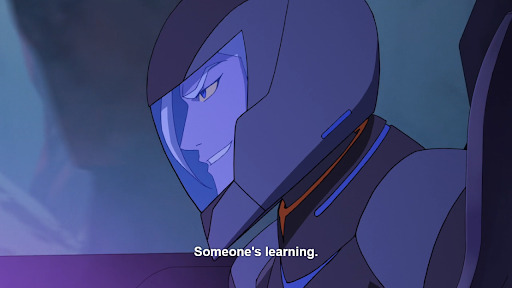
[Image description: Prince Lotor in profile, a pleased expression on his face, and the subtitles read “Someone’s learning.”]
As a brief aside: the animus comes from Jung and is often paired with an anima, or masculine and feminine energies. The key takeaway is that these energies are complementary to each other and exist in a balance. While they typically are portrayed in a more heterosexual context, like everything else in this meta, the terms are used in a gender-neutral context when not applied directly to Allura’s storyline. While Lotor could be likened to either Meeting the Goddess or (Wo)Man as Temptress in the hero’s journey, a key difference between the heroine’s journey animus and either of these feminized roles is that the Goddess and Temptress are two separate figures--generally women to male heroes--and are generally not equal to the hero physically or mentally. The animus, however, is intrinsically the perfect match to the anima of the heroine, being their complement and their intellectual and physical equal. Lotor is not meant to be seen as the woman on Indiana Jones’ arm, he’s meant to be a force in his own right, challenging Allura to better herself and raise the standards for them both. It’s fitting that this occurs in an episode full of fog and a dangerous abyss, because the traditional hero descends into a metaphorical (or literal) one to encounter these flattened versions of feminine energy.
The trials continue for Allura through the seasons, and she makes many allies and continues to face their enemies head-on, and once Prince Lotor, now Emperor, cements his place as one of Allura’s allies he shifts from the Shadow figure challenging her to the animus in full, being encouraging and supportive as they work together as allies to find Oriande, a mythical place that should yield them the secrets of unlimited Quintessence. While Lotor challenges Allura in a traditionally masculine way (physical trials, battle, strategy), he also encourages her in a decidedly feminine way through Altean history and mythology, as Altea is very feminine-coded compared to the Galra Empire, which through Zarkon represents a familiar and violent strain of masculinity that seeks to crush Allura and force the universe to fit his will through abusive language and physical violence and genocide. Allura taking up the battle in Alfor’s place is simply her continuing the cycle and seeing power in masculine terms, rather than breaking the cycle.
Now here is where the diagrams diverge even further. Until this point, the journeys followed fairly similar trajectories. After the trials and battles of the heroine’s journey, they experience the boon of the journey, which the hero does not achieve until they face further trials and temptations. As such, we will continue to follow the heroine’s journey model and I’ll explain the significance of the flip.
Part II: Not the Place to Arrive
One of the significant things about the heroine’s journey is that when a woman undertakes it, it’s empowering and her becoming her most unified self. Campbell once reportedly said to Murdock, “Women don’t need to make the journey. In the whole mythological journey, the woman is there. All she has to do is realize that she’s the place that people are trying to get to.” In the hero’s journey, often a woman’s place is as the prize, rarely is she her own agent. As I stated previously, the hero and heroine journeys do not have to ascribe to gendered protagonists, however the reality is that the hero’s journey is very patriarchal in nature since it was formulated primarily through the study of male heroes and does not take into account the constant reassessment heroines must face. For heroes, they simply must survive going from point A to point B. Heroines are always subjected to reevaluation within their environment and the people around them, so their journey never really ends.
All this is to say that the hero receives their boon at the end of their story and that’s the end of it. They get a happily ever after and can return to normal life and spread their bounty to those in need or dearest to them.
The heroines?
They get their boon at the middle of the story.
And there’s still more to come for our heroine as they build toward the climax (pun intended).
Princess Allura receives the boon of Oriande’s secrets with Lotor by her side, which in pretty much every literature class would become a discussion on the ways this represents sex, or the the ways Allura is interacting with the world in terms of gender, particularly how they discover Oriande after having an emotional reaction in Haggar’s lab and activating the Altean compass stone. In the heroine’s journey, this boon is often of the same significance as the hero’s boon/reward at the end of their journey, but for the heroine it’s false. It’s fleeting. It’s not meant to last. This is the turning point for our heroine because while yes, our heroine achieved the goal of the adventure, they did so by consciously or unconsciously shunning the feminine. In Allura’s case, she’s still taking after her father, trying to follow in his--and to an extent Zarkon’s--footsteps by mastering the unlimited Quintessence.
And true to form, before season 6 is out, our heroine seems to be betrayed by her animus, returning him to the status of Shadow figure as he challenges her to unleash the power within one final time. Princess Allura thinks Lotor lied to her and has been harvesting Alteans for their Quintessence when Keith and his mother Krolia discover a living Altean in the Quantum Abyss, and with the budding on-screen romance between Allura and Lotor, this betrayal cuts our heroine deep. To her, he not only lied about there being no more Alteans left, but he actively continued the genocide his father began 10,000 years ago. That’s not an easy thing to get over. So Lotor assembles Sincline, which bears a visual resemblance to a wingless dragon--the last metaphorical dragon she faces before moving into the next step of the heroine’s journey--and with Allura in Voltron the two battle it out in a tragic action-packed scene that leads to Voltron overloading Lotor with Quintessence and leaving him in the Rift.
With the dragon defeated and the boon lost, the heroine has to sacrifice not only her animus, but the last vestiges of her home to try and undo what following the masculine has done: close not only the original Rift, but all the fractures in reality caused by their battle.
And what does a girl who has already lost her planet, people, and lover have left to lose?
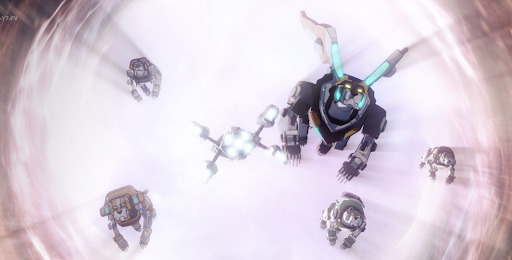
[Image description: The five Lions of Voltron flying away from the massive Rift, the Castle of Lions flying straight toward the center of it.]
The heroine following the footsteps of the masculine always comes at a major cost to them. In Allura’s case, she has to sacrifice her castle in order to make right the harm done to the literal universe. In this case, she mirrors Zarkon in his destruction of the universe, but rather than directly harming billions of lives on uncounted planets, she creates a literal hole in the universe because of her blindness to the consequences of the actions of herself and those around her.
And much like her father sending away the Lions, she must send away her castle in the hopes of saving the universe from greater destruction.
Part III: Transcending the Rift
From the gain and loss of the boon, things look dire for the heroine at this stage in the journey. In Allura’s case, she is without people, without planet, without castle, and as she learns at the beginning of season 8, her found family has families of their own--other than Coran, that is. Our heroine continues to lose pieces of the things and people surrounding her at the beginning of the story: which Murdock refers to as awakening feelings of spiritual aridity or death. She is losing her place in the universe even faster than before, when she stood on the shoulders of her father, and she must move forward. Allura passed the point of no return all the way back in season 1 episode 1. As the heroine, she broke free of the safe mold she knew for the past 10,000 years, and every episode since her awakening she has had to try to forge forward on the path she knew: that of her father. Now, though, her father’s methods have failed her, just as they failed him, leaving her with no option but to keep moving forward and to approach her journey from another angle.

[Image description: from left to right, Veronica, Allura, Romelle, and Pidge (mostly off-screen) in a clothing swap shop as Allura speaks. Caption reads, “I could give you a royal decree of service from the Crown Princess of Alte…”]
Allura not only must deal with the loss of her place in the universe, but she must also deal with the fact that by leaving Lotor in the Rift, she abandons half of herself as well. Physically she is a whole person, but if we look at her role as an anima and what her fears and strengths are, destroying her animus throws her self-knowledge out of alignment. She’s careening away from the safe path of her father, but she must now rediscover the strengths within herself without succumbing to her weaknesses and do so by stepping out of her father’s shadow.
Season 8 is rife with emotional buildup and no payoff. We as the audience don’t know what happened to Lotor for the whole of season 7 and we see Allura struggling to deal with all her losses, we travel to Earth and meet the MFE pilots, a plucky bunch who probably were meant to lay groundwork for a new Vehicle Voltron, and we see that Haggar/Honerva is the final big bad of the whole show, ready to vindicate the son she lost to the Rift, but also 10,000 years ago when he was born and she became the Witch we love to hate. So when we join Allura and the gang on Earth with Luca in the infirmary, and Allura’s final trials begin…
Or they should have.
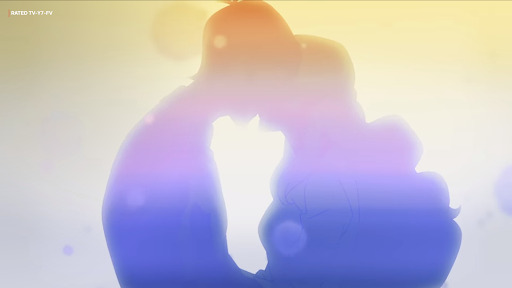
[Image description: Lance and Allura kissing in rainbow lighting where they are artificially-colored in red, then pink, then blue from top to bottom in front of a fading background of warm yellow at the top to gray at the bottom.]
Instead, we are treated to the final acts of a hero’s journey, but still following our heroine through the steps.
Our heroine wears down to the persistence of Lance, who in a heroic journey would receive a fair princess as his boon, and Allura is trying to find a place to belong. In seasons prior to this, Lance acts like a goofy everyday guy, very much a typical character in many present-day stories that allows the audience to see themselves in him. He fantasizes about wooing the princess, calls himself a ladies’ man, tries to be funny, he’s a pretty typical character that a male audience is more likely to sympathize with, and as such the fantasy is pairing up with the prettiest, smartest, etc. girl in the story. The woman as a boon, the Goddess, and the Temptress are never on equal footing with the male hero, and even in the case of female heroes, the meeting with a god(dess) means that the female hero is worthy of being a consort rather than the equal that a heroine is to the anima/animus. In fact, Campbell reportedly told Murdock, “Women don’t need to make the journey. In the whole mythological journey, the woman is there. All she has to do is realize that she’s the place that people are trying to get to.” In the hero’s journey, if the hero is male and heterosexual, the women will always be the prize, the virginal ideal, or the sexualized damnation, and in all of them, the woman is meant to be receptive to the man (and doesn’t THAT sound like some familiar rhetoric). Never is the woman an agent in the hero’s journey when it fulfills a male fantasy. And it is this very same box that spurs a heroine to begin their heroine’s journey: this breakdown of people to individual parts as determined by a patriarchal society.
While Lance is a hero in his own right, in Allura’s heroine journey, he acts as an ogre that comes dressed as a male ally all the way back in season 1. He’s a Subverted Nice Guy in that he’s constantly trying to woo Allura, but ultimately he’s still reinforcing the same patriarchy that not only plagues Allura in this iteration, but also in previous iterations of the Voltron franchise. The Nice Guy doesn’t challenge the heroine like the animus, but rather encourages them to stay in place or to fit a predetermined mold once more.
Look familiar?

[Image description: Lance’s fantasy, with him standing triumphant over Zarkon as the team cheers him on, Allura kneeling at his right side and looking up at him, while a flag with his face waves on his left.]
Many of the silly shots in the series have been foreshadowing, whether in the most direct sense or in the promise of subverting what’s portrayed. In the case of this screenshot, by the time Lance gets the girl, Zarkon is killed (by Lotor), Allura has already had an intimate relationship (with Lotor), and the team collectively became heroes and allies of Lotor before the end of season 6 happened. Lance, textually, is not Allura’s equal as an animus, and while he doesn’t quite view her as his equal--especially in earlier seasons--he can only textually become her equal when she is at her lowest point, and he’s still affixed to the idea that she’s a prize, going so far as to say that “winning prizes is my specialty” in “Clear Day”. Really, it’s a messy relationship dynamic that tries to show the audience why, as they stand in the canon material, they don’t work. Not only is Allura still not his equal, but his fantasy comes about at the hands of others, or with the help of others, and he comes second. He plays a role, but he is not the singular hero he once fantasized about being. Textually this subversion is teaching him a lesson about becoming his best self and acknowledging that he doesn’t have to be the hero, the payoff of which should have come in season 8 as Allura completes her heroine’s journey to become her most unified and realized self. It’s meant to be his apotheosis, the new perspective and enlightenment brought to the hero after facing all the trials of the journey as a part of the final reward.
Allura, fighting with this sudden loss of herself, must now also help spearhead the war against Honerva, the archetypal Bad Mother, in an alchemist-versus-alchemist battle for not only Lotor’s physical soul but for Allura’s metaphorical one as well. This is a new fight, the gauntlet thrown by someone other than her animus, and after all his tests, she must still rise to the challenge with the same energy, but she must do so with new knowledge now that she knows she cannot rely solely on her father.
But what’s the next step for a heroine trapped in the arid desert of the unknown self and with the weight of the world pressing onto them?
They must descend to the underworld and begin the transformation from the masculine methods to unleash the femininity that’s been locked away this whole time.
And who do we have to escort Allura to the metaphorical underworld as she falls asleep?
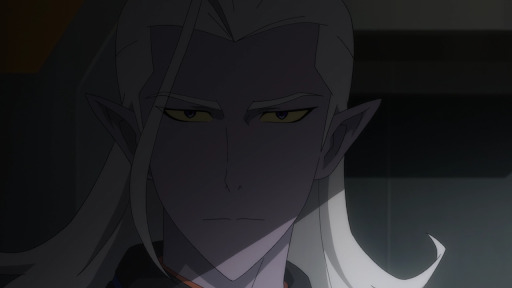
[Image description: A close-up of Lotor’s face in deep shadows as he stares head-on at the “camera”.]
Her Animus, acting as a Shadow once more.
His entrance is littered with sex. Not literally, but metaphorically. He greets Allura while she’s in bed, the camera does a gratuitous slow pan over his body in a way that many cameras exclusively afford to women, the presence of a blooming flower with an erect stamen, the lighting of the preview--altered in the final season itself--is purple even, a romantic and spiritual color. You know the joke in college English classes about how everything is sex except sex? That’s this scene in a nutshell. He’s always been drawn and behaved in a way designed to appeal to the female gaze (an essay in itself), but this scene really takes the cake.

[Image description: Lotor as viewed in profile from a low angle in a Garrison room, looking down at a juniberry flower in a pot.]
And it’s this scene where we see Lotor give Allura the first critical piece of information for how she can stop Honerva/Haggar, but also reminding her that some people do not change. While Allura must change to achieve her realization, he reminds her that Haggar is still the same witch, and that her pain of losing Lotor becoming public does not excuse the fact that she has not expressed remorse or tried to change herself, let alone her hand in not only his downfall but in the brainwashing of the Alteans. She is an antagonist so focused on the wrongs done to her that she justifies the wrongs she does to others with them. Allura, however, expressed remorse and wanted to save Lotor as soon as she realized what was going on, which further cements the ways in which their fates could have been the same or switched had they made slightly different choices. Honerva is 10,000 years too late. Like Lotor mirrors his father and in “Shadows” is shown to be more empathetic, Allura mirrors Honerva and both prove throughout the show to have stronger moral compasses than their predecessors. They are the Emperor and Alchemist, and while fate decrees they must take up the mantle left behind, their free will dictates that they should not blindly follow their footsteps if they truly wish to make a lasting change. Narratively, they must forge a new path if they are to bring the universe to peace again.

[Image description: A close-up shot of the juniberry flower with Allura visible in the background, but blurred. The subtitle reads Lotor’s line, “The witch may change her name, but she will always be a witch.”]
Lotor tempts Allura to take the entity into herself, and when she reaches out to connect with it, she is taken further into the dreamscape and finds herself back on Altea and greeted by her mother. This marks the beginning of the reconnection with the feminine, but while Allura has always so desperately missed her family and Altea, she finds herself in a precarious position. Suddenly, she is in the very same mech suit that Luca was found in, and to save Altea from the Galra fleet overhead, she makes the decision to use the planet’s Quintessence. However, in the process of destroying the Galra fleet, destroys Altea as well. As her world crumbles, her mother congratulates her for a job well done. This presumably mirrors the dropped plot about the Altean Colony and the decisions Lotor would have been faced with, and after “Shadows” would lend both Allura and the audience a greater appreciation for the position he was in before he died.
And when she finally wakes?

[Image description: Allura sitting up in the Garrison bunk, looking at the mice, the juniberry dry and wilted in the foreground, blurry. The subtitle reads, “It was only a dream.”]
Our oh so sexual symbol is wilted, and Allura wakes up alone.
With the visual deflowering and this new revelation about the kinds of decisions those before her have had to make, Allura can begin reconnecting with the feminine in earnest without falling into the old placements she may have been subjected to at the beginning of the story. This would have continued further with Allura reconnecting with her animus in the missing episode @leakinghate titles “The Descent”, especially fitting as she continues her descent to her feminine roots as a heroine and to reconnect with her lost animus. Reconnecting and reconciling with him--and with the side of herself he represents--is critical to her achieving unity within herself and being able to face Honerva head-on.
Once the heroine has descended to the underworld, begun the reconnection to the feminine, and returned with new knowledge on their relationship to their emotional side and the aspects overshadowed by the masculine, they are ready to begin healing the mother/daughter split. This in essence is the heroine returning to the old knowledge she has cast aside when following the path of the masculine/father, but approaching it with a new understanding and perspective. Think of it as understanding why your parents enforced rules like “don’t run into traffic”. As a kid, the danger may not be obvious, but as an adult you’re able to look at the same situation, see over obstacles younger you might not have, and realize “oh shit, that’s a car”. That said, the heroine does not allow themselves to get put back into the same or even a different pre-prescribed role because they now have a greater understanding of the situation at hand.
In Allura’s case, this means revisiting the plan on how to take down Honerva, and realizing that she must pursue the course laid out by her trip to the underworld to not only save the universe, but awaken Lotor from being a robeast. Part of the conflict against this plan comes from the team, who see the entity she took within herself as dangerous. While that’s true, stopping the plan also prevents Allura from growing in strength to be able to fight Honerva. The power flowing within her that Lotor referred to back in season 6 is at her fingertips, and like his visit in “Clear Day” reminded her, she need only take it. During both parts of the “Knights of Light” episodes, Allura is confronted with shades of Honerva’s memories as they dive deeper, and it’s here that we as the audience and the cast are meant to learn what truly became of Lotor after he was imprisoned in the Rift, and it’s meant to be utterly jarring to everyone. Instead, with how the scenes were edited together during the post-production alterations, Hate aptly points out in “Seek Truth in Darkness” that Honerva promising vengeance and seeing Lotor’s corpse has next to no impact. Or rather, it does to the audience--a melted corpse isn’t exactly Y-7 appropriate--but the characters don’t really react to this revelation at all.
That said, it’s more than likely that Allura genuinely believes Lotor to be dead (as opposed to a sleeping prince), which would explain her aggressive reaction to seeing pre-Rift Zarkon, and we don’t see his reaction to learning what he did to his son, either. This would be a prime location for Zarkon to experience and express remorse for what his actions have done to his son, subverting the toxic masculinity narrative his character had been representing prior.
At the end of “Knights of Light Part 2”, Hate mentions that Allura would need to make another trip to the underworld to commune with Lotor and realize that no, he’s not dead, but also that she not only must defeat Honerva, she must do so in order to save Lotor and free everyone of the cycle of violence that began 10,000 years ago. This is the final descent she makes before she can heal the wounded masculine, both in herself, and Lotor directly.

[Image description: Allura in profile inside the cockpit of Blue Lion, unconscious. Her window displays measurement increments and stars in red-tones, while Allura herself is lit in blue tones.]
After the end of this episode, however, Hate mentions that much of what was there is butchered in the post-production editing, so I will be extrapolating based on the content we have in the season as well as utilizing her analysis of the story as it should have been.
When Allura wakes up from falling unconscious, this is when we should see her proposing to save her animus, and it should come with a discussion with Lance about how they don’t click romantically. That said, in the version on Netflix, we see their relationship continue, however much of their shared body language doesn’t necessarily even match up with an awkward couple. Lance seems sullen and possessive, and while he might still be sullen in Allura’s original heroine’s journey, he would have had this moment of growth in which he learns to let go of Allura. She’s his fantasy, and not only is that unfair to Allura, it’s also unfair to him, and he doesn’t need to be the hero or the guy that gets the girl. He can be himself, silly, sharpshooting, video game-playing Lance. A genuinely nice dude, which completes the subversion of the Nice Guy trope his character embodied for so long.
“Uncharted Regions” is a hot mess of an episode in terms of narrative flow and consistency, but this would have marked the beginning of the alchemist vs. alchemist fight for not only Lotor’s soul, but the universe. Honerva uses the Sincline mech and her new mech to start tearing holes through realities, and once Allura jumps into the fray, that moves the audience into the next missing episode proposed by Hate: “Storming the Pyramid”. This would be where Honerva uses Allura to revive Lotor because she did not receive the life-givers’ blessing, and Allura would do it, literally healing the wounded masculine, but also falling right into Honerva’s trap in the process. This would almost certainly be a highly-controversial thing among Allura’s allies, but like Allura remaining on the path she knew, it’s easier to accept Lotor as pure evil who got what he deserved, when at no point is there a definite case against him. In fact, “Shadows” is designed to render him as a sympathetic character, and seeing his melted corpse is even more horrifying after seeing him as a baby and child. But that’s the way it is when a heroine breaks the mold. The heroine defines their own role, and as part of that, it gives them the ability to help others break theirs. The heroine experiences true empowerment by divorcing themselves from the power structures that defined them before, and doing so with the greater knowledge of their internal masculinity and femininity. Allura revisiting the war of her father with the lifegivers’ knowledge to compound her intrinsic alchemical abilities is the moment when she achieves union within herself, and it manifests physically as reviving Lotor, her animus.
It’s after this point that we see the Purple Lion and Purple Paladin manifest, our namesake.
In “Day 47”, Kolivan references the team sizes the Blades of Marmora use. He references four and five as the usual sizes, but six occasionally happening, but what he says next is particularly interesting.

[Image description: Kolivan being filmed for an interview, saying, “Seven seems rare, but… it could happen.”]
The Voltron team had four Paladins briefly after Shiro disappeared and before Allura took up the mantle, but the full team always has five. After Shiro returned for good, their team became six Paladins.
Now, with the healed animus Lotor on their side, they could have the rare seven-person configuration that Hate discusses at length in “Seek Truth in Darkness”.
With the anima and animus aligned together at last with no secrets, they can unify externally the same way Allura unified internally, and battle against Honerva properly. Now, Team V, Lotor, and the entire universe can face Honerva head-on and stand a chance at winning.
We also should get the emotional payoff for Lotor as an abuse victim in his own arc, closing up this nice little loose end that hurts way more than it did before season 8 dropped.

[Image description: An up-close shot of Lotor glaring into the “camera” in green lighting and saying to Haggar, “maybe I will take pity on you when the time comes.”]
And it’s worth mentioning that while the final battle is exciting and action-packed, the final surrender of Honerva comes quietly, in the rift of all realities. The characters of Team V are able to deliver their character-based arc lessons, it’s a somber moment of learning as Allura, using once more the blessing of the lifegivers, enlightens Honerva to her memories and what she’s done, but also restoring her sense of self the way Allura was. This is the final healing of the mother/daughter split, and it’s significant that Honerva’s abuse victim not be her healer. Not only does Lotor (as far as we know) lack the ability, but it’s never the victim’s job to heal their abuser, just as it’s not the obligation of the oppressed to appease their oppressor. Honerva can finally move on and begin atoning for what she did by setting the ghosts of the Paladins of old in her mind free, but that still begs the question of what our heroine and her animus must do to finish the job.
This is where Lotor would get his second chance, in the most literal sense of the term, where he faces a similar trial to the one in Oriande back in season 6 and the burning question for a man so concerned with survival and cunning.
Is there something he would give up the life he has known and fought so hard to keep for?
And this time, the answer is yes.
Allura.
It was always Allura.
While Honerva is able to stop the rift from expanding by, well, not expanding it herself, she lacks the ability to properly close it the way that it was closed the first time. It takes one final adventure, one final unification by the anima and animus, by the heroine and her Shadow, and one final goodbye. Allura and Lotor, born of an age long past, become the lifegivers eternal through staying behind to close the rift.
The lionhearted goddess of life and her stalwart champion of survival.

[Image description: The final scene after the credits, where an Allura-shaped nebula is nestled up against a smudged, darker nebula with a sea of stars among them, and the five Lions of Voltron flying toward the nebulae.]
Sources
Dos Santos, Joaquim and Montgomery, Lauren. Voltron: Legendary Defender. Netflix. 2016-2018.
LeakingHate. “Seek Truth in Darkness”. VLD Visuals Detective and Imperial ApologistTM. 2 Mar. 2019. https://leakinghate.tumblr.com/post/183160042843/seek-truth-in-darkness
“Maureen Murdock’s Heroine’s Journey Arc”. The Heroine Journeys Project. https://heroinejourneys.com/heroines-journey/
Murdock, Maureen. The Heroine’s Journey. 1990.
University of Kansas. “Science Fiction Writers Workshop: Joseph Campbell’s Hero’s Journey”. KU Guinn Center for the Study of Science Fiction. http://www.sfcenter.ku.edu/Workshop-stuff/Joseph-Campbell-Hero-Journey.htm
#dragon's ramblings#TeamPurpleLion#vld#the heroine's journey#voltron#allura#lotor#writing#literary analysis#strafe#hero's journey#lance#executive meddling#freevlds8#free vld s8
114 notes
·
View notes
Text
The Other Ships in My Fleet
So, I’ve already made a post talking about how I feel about certain ships in My Hero Academia, and another post about some of my other fandoms. Both posts got a lot of likes and reblogs, so I figured I’d talk about my ships from other fandoms. If this post also gets a lot of positive feedback, I’ll consider starting a second page to post my fan content for all of my fandoms, while still maintaining this one almost exclusively for My Hero Academia and Kiribaku specifically.

Klance (Keith x Lance)
Voltron: Legendary Defender
I’m fully aware that this ship is probably not going to happen, but it’s really the only ship in the series that speaks to me. I will not lie, I am a big fan of dark and moody dating happy-go-lucky, and the rivals to friends to lovers element is just icing on the cake. It’s only further helped by Lance being Keith’s second-in-command. They help each other grow, and the trust that forms between them is cute and endearing. They also shared a major element to their characters. Both of them feel out of place, Keith because of his Galra heritage, and Lance because he doesn’t have a niche role.
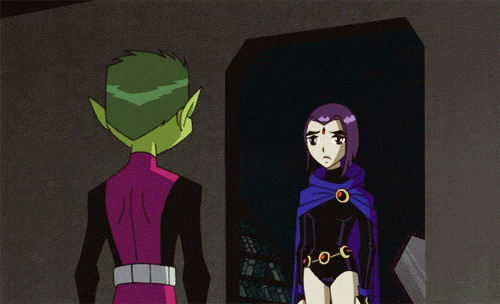
Rabies/Rae x BB (Raven x Beast Boy)
Teen Titans (2003)
While there wasn’t a lot of shipping fodder for these two in the 2003 iteration, the two are a canon couple in most versions of the teen titans, having been married in the comics (more than once, I think) so this is sort of a unique ship in that I ship it across every version of the two characters. Sporting a snarky moody goth and a lovable goofball, their dynamic was like that of an old married couple, or a moody teenager and her annoying little brother. Still, the two were good friends, and even though their personalities were polar opposites of each other, they had a lot of quiet, emotional moments together in the series. Whether you want to read them as friends or potential lovers, I think it’s hard to deny that there was a genuinely nice bond between the pair.

Garnet/Rupphire (Ruby x Sapphire)
Steven Universe
As the show’s literal physical manifestation of love and a perfect relationship, it’s hard not to like the relationship between these two adorable lesbians. With the show sometimes being edited to remove the queer elements, it’s absolutely hysterical that they had the two get married in an episode very important to the plot, and put Ruby in the dress so that absolutely nobody could misinterpret her as a male. Editing it would only confuse viewers as to why everybody is in wedding attire, thus taking a very satisfying stance against censors and bigotry. Garnet also marks a first in children’s programming as the first same-sex wedding in a children’s animated show, at least as far as I’m aware.

Pearl x Mystery Girl
Steven Unieverse
Although only featured in a single episode and having no dialogue, Mystery Girl (possibly named Sabina) is a very important element to Pearl’s character, being her first step toward moving on from Rose Quartz. There were fans that hoped that Mystery Girl would come back, but even if she doesn’t, she’s still important to Pearl’s character development.
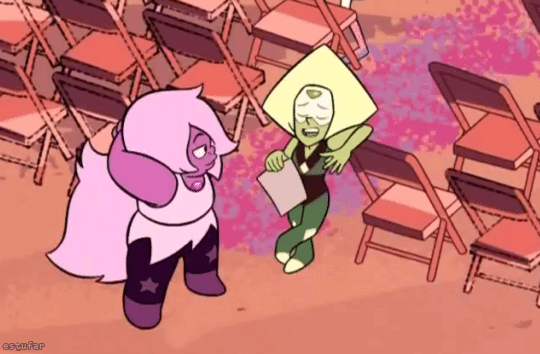
Amedot (Amethyst x Peridot)
Steven Universe
I know a lot of people prefer Lapidot, but frankly I find Lapis too selfish and cold-hearted to be ready for a relationship as she currently stands. I find Amethyst to be a better fit for Peridot, since they both share issues with their height. That, and the way the show frames them has romantic comedy tropes interwoven into their scenes. But even if they’re just friends, Amethyst’s approval means so much to Peridot.

Stevonnie (Steven Universe x Connie Maheswaren)
Steven Universe
I’m not usually a fan of lead boy dates lead girl ships, as they tend to be very poorly done, and many feel forced, or are just boring and predictable. However, the bond between these two feels very genuine. They don’t feel like a lead boy and lead girl forced into a relationship at all. They come together very naturally, and the show takes its time to build their friendship up slowly. The show remembers that they’re kids first, friends second, jam buds third, and love interests last.

Tomstar (Tom Lucitor x Star Butterfly)
Star Vs the Forces of Evil
Considering the show’s themes of monsters, racism, and not judging evil at face value, this ship serves as the most thematically poignant to the narrative that the show is setting up. It also makes Star a stronger parallel to her “evil” great great something grandmother, Eclipsa. Both are monster sympathizers with monster boyfriends. While the blood moon bonds complicate things, I see this ship as the most relevant to the themes and messages the show seems to want to send.

Tomco (Tom Lucitor x Marco Diaz)
Star Vs the Forces of Evil
More of a joke/crack ship, I know it’s unlikely, but the entire episode of Friendenemies had romantic comedy written all over it. Between the literal in-universe break-up song to the show’s promotional art being inspired by dime store pulp romance novels fuel the fire that keeps this ship afloat.
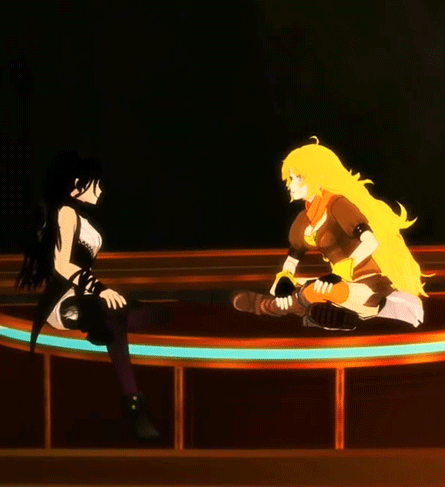
Bumblebee/Bumbleby (Blake Belladonna x Yang Xiao Long)
RWBY
Partners, teammates, and close friends, the ship really took off starting in season 2 during the episode “Burning the Candle”, as Blake spiraled into self-destructive habits due to obsessing over her problems. Nobody is able to get through to her until Yang comes in to talk to her. She doesn’t lecture her or beg her to stop. She instead forms a bridge of trust by first opening up about a similar situation she’s been in, and how she knows first hand that this sort of spiraling can only have negative impacts. They are shown to be parallels, as both girls are negatively effected by a loved one no longer in their life, and the trust issues that spring from that loved one’s actions. Yang was abandoned by her mother, a problem which she mentions Blake repeated. For Blake, it was the uncertainty of trusting someone’s character, and being afraid of someone slowly turning into someone else. She explicitly states in season 3 that her ex started off a nice guy, like Yang. The first time he hurt someone, there was a reason. There was always an excuse. Until eventually, she became the pardoner. The one excusing his actions. And, she expresses the fear that Yang could be following a similar path. Both girls have been hurt by someone in the past, and both girls are afraid of being hurt the same way again, and inadvertently hurt each other the same way as someone else has. It’s also known that RWBY characters tend to represent or be based on fairy tale characters. Yang is Goldilocks, and Blake is Beauty from Beauty and the Beast. However, based on the lyrics from Red Like Roses “Black the Beast descends from shadows, Yellow Beauty burns gold”, there seems to be an implication that Yang is the Beauty to Blake’s Beast. This is interestingly supported by Blake’s name. Blake is a Celtic name meaning both Black and White, and Belladonna literally means Beautiful Woman in Italian, but is also the name of a very poisonous plant often mistaken for the harmless blueberry. The duality of her name could be pointing to how she plays the dual role of both Beauty and Beast.
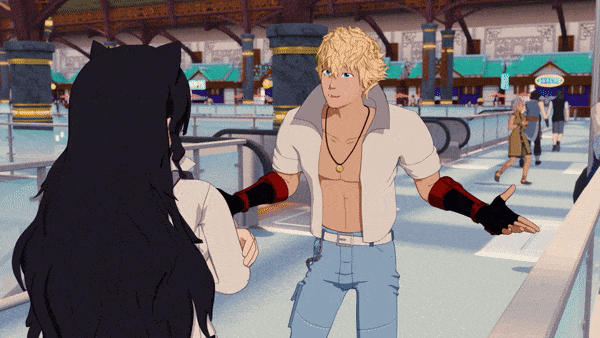
Seamonkeys (Sun Wukong x Neptune Vasilias)
RWBY
A bit more of a crack ship, these two lovable idiots are far less likely to be canon, but since Sun is Yang’s main competition for Blake’s heart, I have no problem shipping him off elsewhere with his goofy best friend. Although they act more like usual best friends in the canon show, their relationship does have a much gayer tone in the less canon comedy show RWBY Chibi, where Neptune almost seems to act like a jealous clingy girlfriend a lot of the times. I doubt the ship would ever sail, but I mostly ship it because they’re cute together. Although, with season 6 just starting, I got the vibe that Sun was stepping aside to let Bumblebee sail uninhibited. Sun doesn’t really have a third popular ship, it’s just Black Sun and Seamonkeys, so this ship may be gaining validity in the future.

Gumlee (Marshall Lee x Prince Gumball)
Adventure Time with Fiona and Cake
The male counterpart to Bubbline (Princess Bubblegum x Marceline), there’s no real difference between the two pairs other than their genders, and Gumball preferring baking while Bubblegum prefers science. Because they are effectively just gender-swapped clones of the canon ship, anything canonical between the girls is also technically canon with these two. It’s not that I don’t like Bubbline, but when given the choice between gay or lesbian versions of a couple, I’m going to be naturally inclined to lean toward the gay version.

Sasunaru/Narusasu (Sasuke Uchiha x Naruto Uzumaki)
Naruto
Maybe there’s a cultural aspect I’m unaware of, but it’s a bit of a running gag in the Naruto fanbase at this point that Naruto is obsessed with Sasuke. So much so that he seems to care about him way beyond normal friendship. With how much these two obsess over one another, it’s no surprise why this became such a popular pairing. Their dynamic even dwarfed Hinata’s heartfelt confession of her love during the Pain Invasion Arc, because as soon as that ended, did Naruto go talk to Hinata? No, he immediately started thinking about Sasuke. Hinata definitely got the shaft in part II, which is a shame because I really loved her character.

Bob and Linda Belcher
Bob’s Burgers
More of an honorable mention than a full on ship, I wanted to highlight them as one of adult animation’s only married couples that actually still like each other. In the wake of the popularity of the Simpsons, and the cementing of the genre with Family Guy, the stock dynamic of idiot husband and enraged but supportive wife became a recurring trope. Before long, every single animated sitcom-esque family fell into this very annoying cliche. So, finding a couple in adult animation that are not only married but still manage to show they love each other is amazing. Their marriage isn’t on the rocks, they find time to at least try and be romantic, and even when they have bets or are on opposing sides of something, the show never forgets that these two love each other at the end of the day.

Captain Swan (Killian “Hook” Jones x Emma Swan)
Once Upon A Time
This relationship between Captain Hook and the daughter of Snow White and Prince Charming might sound odd on paper, but this couple is by far one of the healthiest relationships in the series. Both Hook and Emma come from broken lives, and together build themselves up to something stronger. In a melodrama surrounding fairy tales, both characters are surprisingly grounded, realistic, and skeptical cynics, a very stark contrast from the usual wide-eyed lovey-dovey couples Disney is known for. Emma’s tendency to put up walls and Killian’s tendency to always put himself first are both slowly broken down over time as Killian tries to tear down Emma’s walls and get to know her while she works on building a foundation of trust between them. The pairing feels very organic, and they definitely feel like the most realistic couple in the series as they both take turns stumbling and working toward being good for each other.
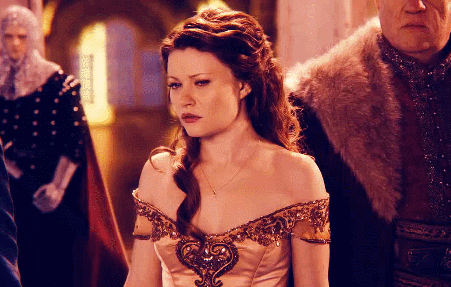
Rumbelle (Rumplestiltskin x Belle)
Once Upon A Time
In the early seasons, this couple was beautiful to watch. I truly loved their chemistry and dynamic, as both of them were given such strong characteristics without simplifying either of them. However, as the show went on, it started to lose that power. The couple started to feel toxic as Belle kept waiting for Rumple to change, and he kept on lying and lying. It even reached a stopping point. A perfect one. Rumple was redeemed. He was a good man again. He could be the man Belle deserved. But instead, he slipped right back into his old ways. It was then that I fell off the band wagon for this ship. I loved it once, until I got sick of watching him hurt her over and over.

Daenerys Targaryen x Khal Drogo
Game of Thrones
Although together only for a short while, this power couple won audiences over very quickly, as Drogo’s gruff but passionate affection mixed with Danny’s growing confidence and rise to power made these two iconic.

Renly Baratheon x Ser Loras Tyrell
Game of Thrones
Another short-lived relationship, the remarkable thing is that Renly was literally the only character vying for the throne with fully good intentions for the realm. He was concerned with the needs of the people, and was the only morally good candidate in the War of Five Kings. Sadly, the ydidn’t get much screen time, but they were still a strong couple.
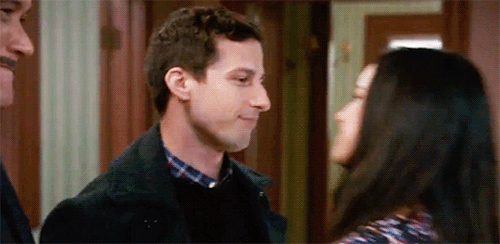
Peraltiago (Jake Peralta x Amy Santiago)
Brooklyn 99
A rare exception to the don’t force the leads to date rule, the show let them form a bond over time that went from a friendly childish rivalry to a friendly dating rivalry. While each character experiences change and growth, it is not at the expense of their personalities, and the progression feels like it was meant to happen.
#ships#shipping#fandom#steven universe#star vs the forces of evil#game of thrones#brooklyn 99#once upon a time#ouat#star vs#rwby#naruto#voltron legendary defender#voltron#teen titans#bobs burgers#adventure time
463 notes
·
View notes
Text
Thoughts on VLD
What is there to say about this series? How does one encapsulate in one sentence all that this was, all that it ultimately came down to be?
You can’t.
But, in this essay, I will try.
So, let’s start with the simplistics.
The first two seasons are the strongest of the series, with the tightest storytelling and does so much to convey things about the plot and characters to the viewing audience at a pretty fast pace, one that makes you want to keep watching.
The characters, all of them, throughout the series, are memorable. They are unique personalities and are pretty decently individualized in design. They’re great, and I love them. The lore, too, I love.
...I came into this series with about as much understanding of what voltron is, as any new viewer. The most I could say about it is what Deadpool described it: five mini lion bots come together to make one giant megabot.
I thought it was gonna be a lot like power rangers. But, like, in space (no, not like that one iteration of power rangers literally called Power Rangers In Space).
Instead, the series looked gorgeous, the animation from beginning to end is stunning, the music incredible, the voice acting stellar.
And the writing?
The writing had so much potential, the kind of potential that you can physically see on the screen.
But getting back to the point. The first two seasons are the strongest, and for one simple reason.
The protagonists had a clearly defined end goal: to defeat the antagonist.
Voltron must defeat Zarkon.
And they do! In the incredible finale, Voltron defeats Zarkon at the end of the second season, culminating the end of the first arc.
Which makes everything that happens afterward hurt so much more.
Because what happens next? What happens when you have the protagonists defeat the antagonist one-third of the way through the series?
A mess, apparently.
Lotor comes into the scene, and is framed as an antagonist, until he isn’t, until he is, until he isn’t. Shiro returns, but not even the writing can decide if this is Shiro But Brainwashed or Clone Shiro. And then he is a clone, but he’s brainwashed, but he’s evil, but he’s not, and also the Shiro from before is dead, and…
Yeah, they needed better writing.
The clone storyline was something that, done well, I would have accepted wholesale. As it stands, it was drawn out for far too long, criminally underexplained, and had an ending that I am still upset about.
The Galra Empire was the enemy, with the Galra being the enemy, until they weren’t, and then they were, and then they weren’t again. And while I love the Blade of Marmora, and I love the idea they presented of things being murkier as the dismantling of the empire happened, and while “what do we do with the Galra afterward” is a great question… we didn’t get that.
The Galra Empire effectively was reformed under the Blade, in the end.
And Allura died.
Every character deserved better. No one had any real development after the second season, since they didn’t have a goal anymore to grow towards, no end villain that the series was building up to.
And no, Honerva doesn’t count at this point. She could, but with what her final endgame was… no. Her endgame is not what the series was building up toward.
Frankly, there’s only tenuous connections between the starting point and the end point of the series, and while protagonists evolve (I guess we can count what happens as character evolution) and new antagonists appear, where a series like this ends should be the rightful culmination of where it began.
Which isn’t to say that it couldn’t have had a better ending, that we couldn’t have kept Zarkon’s defeat at the end of s2 and still had a great ending without him. It was there, for sure (yes I know, this is getting into my fix-it territory).
But with season 3, with the dogged determination to put Keith in the leadership spot, came the dismantling of what could have been a great series. Allura’s leadership was undercut, and everything she tried to do she somehow got punished for (connecting to Altean culture? Oh, her new love has been hiding a secret Altean colony whose members worship him and whom have had a number of their people straight-up die/get siphoned for quintessence. Build the coalition? Oh, it’ll fall apart as the war starts back up. Make a new Voltron? Oh, it’s gonna be used for Eeeevil).
Allura sacrifices and sacrifices and loses more and more until all she has left to give is her own life.
I have never read The Giving Tree, but at this point I don’t think I have to. Is it at all like Allura’s treatment? Yes? Okay, I don’t need to read or know anything more.
Pidge finds her family, after a pair of fake-outs that, while yes one of them does provoke a lot of emotion, amount to nothing that really challenges her. She’s never presented with a situation where she has to choose between helping her team or finding her family, not intensely.
Lance constantly worries about his place on the team, and it’s never addressed or resolved and in the end he comes across as depressed and sad and deciding that his only worth is loving Allura. He’s never given support by his team, instead they end up mocking him or making fun of him or not standing up for him when a literal god-like entity does the same.
Shiro dies and dies again and again, losing more and more with each death, until he ends up losing even the most basic of story points afforded to him (defeating Sendak) or even being a main character.
Hunk… gets one arc, in the first season, and then gets the arc steal from Lance on Earth. He doesn’t get anything else. Once upon a time he was an engineer, a brilliant one, and in the end… he wasn’t. Yes, he was also always something of a gourmand and a chef and he ended up being a chef.
Which… yes, that’s nice and fits what he liked to do, but not at the expense of the series completely forgetting that he was a brilliant engineer.
Keith… honestly? He was better in the Red Lion, as the red paladin. He took too much spotlight away from the others, the story twisting itself to make him out as the better person even when he was shoving his way out of Voltron. The narrative forcing him to combat Shiro for a spot that he shouldn’t have: the central protagonist. There’s even an entire episode about it, where they literally fight and in the end the Black Lion flies to save Keith, the Black Bayard appears for Keith, and much later on the original black paladin gives his approval to Keith.
He comes out of the series with a magical dog, a magical sword, an alive parent, the status of leader, and the status of main character. Of those, only one we have seen him struggle to retain (the magical sword).
Lotor was set up and played out as an antihero, someone who tried hard to do good but through evil means, someone with a terrible past that he was working hard to overcome and be better than, and… he ended up accused of something that we still don’t know if he really did, was pushed to the breaking point and then left for dead. He was accused of becoming his parents whom he didn’t want to become anything like, was forced by the plot to become that which he dearly didn’t want to become, and died horribly for it.
I could go on, could list out characters that were underutilized (Coran, Kolivan, Matt, Olia, Slav, the rebels, the blade, the coalition, the generals… basically the whole group of side characters, and half of the main characters) but instead…
Lost potential.
Wasted potential.
These are the most I can say of this series. There was potential, even to the very end there was potential. But instead there was nothing left that didn’t get explore enough, didn’t get anything enough.
The potential is there, more than enough to fuel fandom for years, but none of it got explored or developed within canon.
Lance got a sword upgrade, and did nothing with it.
Hunk got a turret upgrade, and nothing came of it.
Keith got a teleporting cosmic dog, and… honestly? When it went off was so strangely placed that it didn’t feel like a payoff. That whole fight with the druid felt so strangely done, that I didn’t feel as engaged as I should have been.
They could track the comet in s3? Well then why did Voltron stop tracking the comet entirely.
Pidge and Hunk were combining Galra and Altean tech and using it to improve the Castle? Well then why was it someone who didn’t do exactly that to build the Atlas. Why was it Sam Holt and not Coran, Hunk, and Pidge leading the construction?
Why, then, did we have to have that weird backdoor pilot to the MFEs in the middle of season 7? Well because they’re a better found family than our Paladins, apparently.
Seriously, they are. The MFEs are a group of people all brought together and become more like a found family than our Paladins, simply because we see them all dining together, and hanging out when they’re off-duty. They come across as actual friends, having actual conversations with each other instead of grouping off and low-key antagonizing one another when they have half a chance.
Our Paladins are not a found family. I hesitate to say that they’re even friends. At best they’re close workplace colleagues. The Paladins we assume would be friends (Lance and Hunk, the Garrison Trio) are not, and we’re heavily lacking in seeing them together in groups. Shiro and Hunk don’t share a conversation, nor do Keith and Pidge, and Lance is just… again, I use the term “workplace colleague” to describe his relationship with anyone on team Voltron.
I’m biased toward Lance, I admit that, but even then I still wanted more. Not just for him, but for everyone. They are all fantastic characters in an incredible world and they deserved better writing than they got.
Entire elements are missing from the story, to the point where having transcripts of showrunner interviews is required to understand what’s happening.
And that’s not good.
Shiro is revealed as gay in the same scene where he’s revealed to be slowly dying of an unnamed illness. It’s not explained in the series that he was ever cured, or that his clone was ever cured.
Shiro is brought back to life, is saved from a permanent death by the Black Lion, and what comes from it is… he’s suddenly not a part of Voltron anymore.
No, really. Discount anyone who heard from that interview, and just from the text of the show nothing about Shiro has said that he was unable to fly the Black Lion, or is no longer the Black Paladin. Nowhere in the text of the show does it say that, only that for some unknown reason Shiro just isn’t a part of the team anymore.
The mark of a good story is that you can create meta connecting the lore and everything tracks perfectly. You’re as much filling in the blanks as you are discovering that there are no holes in the story. It’s not necessary to understand the story, but the meta uncovers new depth and puts to words why and how the story comes together.
The mark of a poorly done story is that you have no choice but to create headcanons and fanon to get everything to track. The more you’re filling in the blanks the more you’re discovering that the holes get bigger and bigger, and there are more and more of them. Eventually you’re not doing meta, you’re doing fix-it fic. The difference is that meta helps understand the story, while fix-it fic makes the story make sense.
In an earlier point I said that the first two seasons are the tightest and the best of the series, and I meant it. I still mean it, even in light of the series itself.
To make a good series, or to make a story, means that there needs to be an end goal, something for the plot to have a climax toward, and all the development to build up toward.
Fitting that, is the first two seasons. And only the first two seasons.
Everything that happens after the first two seasons, lacks something that it was all building up toward. The series lacks something that it was all building up toward. From the start, the thing that it was building up toward was the defeat of Zarkon. Which was what we had happen one-third of the way through the series.
If Zarkon was not the end goal for the series, then the tilt-shift should have been better done.
If the clone storyline was meant to exist within the series, then it should have been better done.
There is a way to have kept a solid track, where Haggar/Honerva was the Final Villain, that could have had good buildup. There was a way to have the clone storyline, and to have the Lotor storyline, and not have it all feel like set dressing to the Next Big Battle.
Everything from season three onward is a series of events with little connection or bearing beyond “here’s a set of character names and putting them into different events with different accessories that have no bearing beyond the episode they appear in” and even then it’s a stretch.
Oriande meant nothing. The White Lion meant nothing. Atlas meant nothing. Sincline meant nothing.
Kuron meant nothing.
Lotor meant nothing.
They were all pretty set dressing on the way to the Next Big Battle.
All of it was either buildup with no payoff, or payoff with no buildup.
VLD, in the end, was like a flat painting that tried to play at being a sculpture without any of the necessary work. It looks pretty, and has great individual parts, but the depth is fake and only gets even more fake when more fake depth is piled on top of it to distract from all the depth that isn’t there.
And eventually, it got to the point where you can see the seams.
The final two seasons were written with certain things in place, and then the final season was rewritten, supposedly because Keith was most desired in the Black Lion. And then that gave us most of what we got for the final season (subtracting the late-stage additions).
But those certain things that the final two season were written with?
Shiro’s return to the Black Lion.
Keith’s return to the Red Lion.
Lance’s return to the Blue Lion.
Allura taking up the helm of the Atlas.
But season eight was rewritten, late in the game, so season seven was altered into what we got, removing all of that.
Removing Shiro entirely.
At least until he was put back in.
Others have said it better, the copy-paste theory. They’ve also said it better about the morals and lessons the latter part of the series meant viewers to take away compared to the early part of the series.
But honestly? Whatever better version there ever was, it’s long gone. All we can do is see in the final two seasons the ghosts of that better version, in the dialogue (Shiro’s lines are now Keith’s, Keith’s are now Lance’s, and Lance’s are now merged into Allura’s and Shiro gets the scraps) and in the visuals. The furthest that better story ever got was into the storyboards, working with those scripts, and other than that it is long gone. There’s no getting it back.
So… what do I have to say, in the end?
We got so close to a perfect iteration. By hook and by crook, we got close to something great.
Maybe next time we can actually have it within our grasp.
#puppet gets salty#I ARRIVE AFTER FOUR MONTHS WITH MY THOUGHTS ON THE SERIES AS A WHOLE#it took me this long to get to say it all without getting way too emotional
68 notes
·
View notes
Note
Do you think originally DW was going to drop the new voltron project sooner (under the assumption they have one) if S8 didnt get the backlash it did? Corporate seems very out of touch.
I don’t know. I think DreamWorks wanted to drop new content in late March/early April for VLD. (She-Ra is now dropping on April 26th, which - geez, @dreamworksanimation. You couldn’t have chosen a better day to drop She-Ra than the day Avengers: Endgame comes out? And if you don’t think girls who like She-Ra don’t like Avengers, you are sorely mistaken, DreamWorks. Superheroes all around, peeps.)
In any case, I guess it really would depend upon what a potential sequel would entail. I would say almost anything that immediately brought back Allura in Season 1 should have gotten the automatic green light, but seeing as we all laughed before Season 7 with the joke, “No worries, everyone. Season 7 can’t possibly be worse than Season 4,” well - I hold no reservations in saying, “DreamWorks can make anything worse.”
But if a sequel had the paladins back in their original lions and Allura alive (as the shirts suggested) or - having taken place in a different reality altogether - a much alive Allura on the castle-ship, a magic-weaving Altean with the ship embodying the White Lion - well, I have no idea why they would hold off.
The best defense is not a good offense. A good offense is necessary for survival. All DreamWorks had to say following December 14th is, “The search for Allura starts on March XX in the sequel to Voltron Legendary Defender, Voltron Blah Blah Blah.”
Many of the complaints, still valid, would have been less “salty,” as it were, knowing that Allura wasn’t dead.
(And despite what Bob Koplar or the former EPs believe - the act of leaving an opening for Allura to “come back” does not change the fact that she did die and it does not make her alive now. And again, despite what Bob may think, death is not the greatest honor the writers could have bestowed upon Allura - and “writers” is not the word I would have used for JDS and LM.)
…where was I? Oh, yeah.
Unless the next Voltron iteration didn’t have Allura in it at all - I can’t see why DreamWorks wouldn’t streamline the heck out of that. Allot more resources. Introduce fans to competent and experienced EPs for the project and put these new EPs on the road. Get Josh and Kimberly on a panel with them. Get Jeremy media training and have him join them, saying how Lance’s insecurities will finally be addressed. Heck - get Steven Yeun to make a recorded message, saying he’s looking forward to the new project.
One single-minded purpose to this marketing campaign, and every collateral and interview should have said the same thing over and over again, “VLD is over, but this new show is ready to go - and fans will want to come back to see it.”
In marketing, a good defense isn’t a good offense. A proactive offense is survival.
58 notes
·
View notes
Text
git along little nonnies
Got a whole bunch of you on related themes, so I’m just gonna do this all at once: a bunch of questions about DW, spinoffs, merchandise, business, management, support (and protest) and whatnot. In no particular order.
Ok there are petitions and peaceful boycotts directed at DW but problem is they aren’t addressing the EPs and things they, not DW, did so how are we to sign them, how to handle this when this could at best confuse the situation and not give any results and at worst, make matters even worse about what we want regarding DW addressing things?
Here’s what companies care about: money. Everything else is gravy.
If you want a corporation to pay attention to your complaints, then you need to figure out their sources of income, and find a way to threaten that. If the social reprobation is high enough, damage to the brand can translate into lost sales, but the tempest required to make that happen must be much, much larger than anything I’ve seen the fandom manage.
I’ve been saying this all along: voices are far more powerful than signatures. If twenty thousand people wrote or called in, and said what they liked vs what upset them, that would have a far greater impact. Certainly a lot more than a list of names with no emotion beyond a request that may not even be something DW can, or would, fulfill.
And don’t even get me started on mailing stuff in. Cute, but hardly actionable.
Do you know what kind of contracts DW sign, as in, are they obligated to air all seasons, can they choose not to air them, do the companies they work with (netflix, wep) have a say or more say than them? Who gets the last word? Is airing all seasons squarely on DW or more?
As I’m not a corporate lawyer employed by any of the signatories, I can’t tell you what the contract stipulated. What I can tell you is that a contract of the magnitude of the DW-WEP-Netflix agreement probably had a dissertation worth of riders covering the different types of possible defaults or breaches, and the penalties for each. Additionally, the contract also likely covered what constituted ‘satisfactory delivery’ of the product.
To take it down to a really simple level: you place an order at a restaurant. You expect to get it, eat it, and pay for it. You don’t expect to be told, “hey, we burnt your steak and we’re out of butter for your sweet potatoes, so have some green beans instead,” and then be told you still owe the full amount, anyway.
Netflix wouldn’t settle for ordering (and paying for) something never delivered, anymore than you would. Sure, any corporation worth their over-inflated stock options would try --- but that’s the point of contracts, to make sure they can’t.
Netflix paid, DW delivers, end of story.
...do you think ppl in charge didn't think EPs would tell they made changes and also thought they'd manage to bury it? And then they got in trouble and DW is going thru changes for that reason? -waves at DW goings on and silence.
I got lost in all the pronouns, there. Who’s the first ‘they,’ the EPs or DW execs? Is the second ‘they’ referring to the same as the first? So... I’m not really sure what you’re positing, but if the ‘DW is going through changes’ is implying DW’s got a shakeup and/or is promoting its head-of-TV to president and that’s somehow connected to two newbie EPs screwing up?
I’d say the chances are so infinitesimal as to be nearly in the negative. (I should also note, the press release listed successful shows Cohn oversaw, yet oddly did not include VLD.) DW is not a three-person start up; it has stakeholders and a board and a C-suite to satisfy. Cohn got that promotion ‘cause she’s got a track record going back thirty years, most recently growing DW’s TV division from 8 to 800 in five years.
Most corporations tend to announce their new CEO or President like someone woke up that morning and went, hey, I’ve got a great idea. Truth is, it’s usually in the works for at least a year, sometimes several years, or more. The only thing that has me side-eyeing the announcement is the silence around who’ll fill Cohn’s previous position.
But that’s again less to do with a single series, and more to do with what it says about DW as a whole, business-wise.
What meaningful changes could the new president Margie Cohn make that would be different than the last one? Also I'm sorry if your getting a bunch of Voltron/DW questions lately, you just seem to be the most knowledgeable person on this platform.
I’d be willing to bet I’m far from the most knowledgeable person; I’m just someone not bound by an NDA, and curious enough to do a bit of digging and jaded enough to talk about (most) of what I find.
A president can have immense impact on a company’s direction; that’s kinda why they exist, to set that high-level strategy. That said, Cohn will be bound by all contracts signed by her predecessor. The TV side (barring someone filling the shoes she left) will probably continue as it was. The theatrical side (which she’s taking over) will be where we’ll probably see any major changes.
And even those aren’t likely to be on films currently in production. Hell, given theatrical animation can take up to five years, I’m not sure that’d show much change, either. Look instead to changes in investors, new deals, and new properties.
What do you think DW will do about a sequel if there’s really no bible? Theres tons of plot holes & abandoned storylines. VLD will never feel satisfying, and fans already argued with different interpretations based on conflicting content, without a nice satisfying explanation...
I know this is the first of a three-part ask, but I’m skipping the rest because the only answer possible is to your very first question: the bible doesn’t matter.
Any new series --- even a continuation --- will construct its own bible. Same as we’d do in fandom: they’ll patch together what they can, fill in blanks as they need, and gloss the rest, or retcon it outright. Even if there were a bible, diligently followed, that doesn’t mean the next series is automatically beholden to it. Some franchises would care (ie Star Wars) while others might let a reboot mess with the details (ie Star Trek).
For every continuation, there’s gradations in between, since otherwise what’s the interest for creative minds, if you’re obligated to follow someone else’s script exactly? So, no. The absence of a story bible doesn’t preclude the next iteration making its own, as it needs, to whatever extent it requires.
I was wandering around the hot topic online store, and i noticed a shirt that raised a few flags and questions. it's the 'Voltron Location' shirt. it has all the paladins in different places in a star globe chart thing? with what might possibly be planet designations. plus Lance is the only one not inside his blue colored bubble. Keith is in Red and Shiro in Black again. it's interesting at least.
Nearly all the shirts use the same base images, just changed up. It feels a little like someone handed a designer a half-dozen images with a request for forty-something designs --- and now HT is just throwing them all at the wall to see what sticks (or sells).
HT’s stuff has been pretty consistent, from what I’ve heard: Shiro is Black, Keith is Red, etc. Considering the t-shirts seem to be selling out regularly (along with various other sidelines), I’d say someone is savvy as to the fact that the segment of fandom spending the most money is also the segment that prefers the S1/S2 lineup.
If that’s what customers want, it’s smart business for DW to provide.
(Yes, that applies on more than one level.)
There are VLD comic books being released by LionForge Comics, are those considered canon? Do LM and JDS have any involvement? They take place before Season 7and8 but I don't wanna support the original EPs.
Every fandom has its own stand on what counts as canon. Sometimes (especially with adaptations) you’ll find fandoms being explicit as to whether they’re book or movie (ie HP and LotR). I expect the same will eventually shake out in VLD’s fandom, too.
From everything I’ve heard, Hedrick and Iverson were handed the comics and ran with it. I suppose that would argue for seeing the comics as canon, being they were written by people also writing the main series... but from what I can tell, it’s one-way. The show affected the comics, but nothing in the comics ever affected the series.
That said, your purchases have nothing to do with the original EPs. All you’re doing is telling DW you like the VLD-iteration of Voltron.
What are your thoughts on the final vld poster? I feel like it’s missing the end. Allura is randomly staring back into nothing.
It’s a clever idea to do a poster for each season, but it’s not something I’ve ever paid any attention to, really. If it were drawn by the head writer? That might mean the artist had more insight than, say, a storyboarder or animator. But even then... cool picture, still not-canon. I’m only interested in canon.
Do you think that Voltron was rushed purposely by the EP's. [...] Wouldn't this effect the quality of, well, everything? I feel as if they got frustrated with the show at that point and just wanted out.
Dude. There are times I sit here and just stare into space, bewildered yet again not just at the thought of 39 episodes released in one year --- but doing that with 26 as a last-minute cut-and-paste rearrangement. All I can tell you is that what I’ve seen from animation people and aficionados (and friends) is that three full seasons in one calendar year is just bonkers.
If DW hadn’t wanted the schedule that packed, the EPs aren’t the ones getting the say. That’s a DW-Netflix thing. I really wonder whether DW used VLD as a guinea pig. TH went a year between S1 and S2, and the numbers slumped badly. Perhaps DW wanted to know if more episodes, more often, would keep fan interest high? DW has experienced execs, but they’re all from broadcast; how you arrange and time things in the brave new world of binge-watching is a completely different beast.
So, it’s possible it was less of a rush job to get the show out, and more from a desire to see what'd happen to release so much, so close together.
I still think it’s a bonkers schedule, though.
"Relaunch the whole property" sounds like they won't continue expanding the whole vld universe and they'll make a new itineration. Though if they do a spin-off it'd likely be on the vld universe surrounding the new "Legendary Defenders" from the epilogue. And "especially given the response" do you think after the negative response from s8, wouldn't be better for WEP to not keep working with Dreamworks? Or maybe they need to clean their brand from vld fiasco? What can you say about all of this?
I can say you might try re-reading, because boy is that a radical interpretation of the text. Remember, Jeremy was speaking before S8, and all indication is that he was caught off-guard as much as the fans. Re-read in light of Jeremy (at the time) appearing to expect S8 to be a crowd-pleaser.
...I'm becoming more confident in my belief that DW has something planned for Voltron. I mean they are still heavily promoting the show, LionForge is still publishing Voltron comics, and merchandise is still being made. These don't seem like the actions of a company trying to get people to forget a show.
You’re not wrong. Up to the last few days of 2018, DW gave every indication they wanted S8 quietly buried. Nothing they’ve done since has fit that pattern --- including the anomaly of failing to announce their 2019 series. Something is going on, that’s for certain.
Did DW really just throw the VAs to the wolves [for] three days? and there's still no official stance? One panel was enough. They had [the VAs] take the heat for them? But thankfully fans felt sorry for them? Which could also have been the goal, shut the fans up [with] the VAs of the characters who got the worst treatment and who love their characters ... Yes DW this really makes me trust you /sarcasm/
I don’t think that was the original plan. Let’s pretend DW released its 2019 schedule via press release in the first few days of January, and among those was an announcement of a VLD sequel or spinoff, coming late 2019.
People wouldn’t be fussing over putting the VAs through three panels. They’d be complaining we didn’t get the biggest room for every panel. The majority of the fandom doesn’t trust the EPs, and is wary of DW --- really, the only ones who retain any goodwill, at this point, are the VAs. So who better than to assure a nervous fandom about the goodness of the second iteration than the VAs whose characters were most shafted by the first iteration?
What breaks this is that immediately after S8 dropped, Josh and Kimberly went silent on twitter. AJ slipped into passive-aggressive snarking; Jeremy fell off the radar and usually he’s pretty interactive with his fans. Bex pretty much wiped VLD from her stream, possibly including deleting older tweets. Neil tried to engage and made a hash of it, bless his heart.
Josh and Kimberly are consummate professionals who reliably promote the series after every season drop, but their radio silence continued for almost two weeks. This wasn’t the first season that came saddled with controversy; if there was a time to go quiet, it was after S7. Something else was going on.
I have strong suspicions backed by research, but if I’m right, I’d be stepping on a major legal landmine. In the interest of not getting blown up, I’ll only say that the VAs appearing for those three panels (and their low-key and mostly diplomatic hedging around VLD’s conclusion) was a good sign that all parties involved are willing to work things out.
[DW was] quick to handle the Season 7 backlash and have stayed mum on what is arguably a much worse reaction to the 8th and final season.
and
I believe the S8 of voltron we got was not the original ending we were supposed to get and highly edited. My question is why? What was the point of changing the original ending? [The] radio silence from DW and the cast is driving me nuts. I wish DW would make a statement.
DW is in an interesting place. Its TV side is barely five years old, but dominated by execs with long-time broadcast experience, predating vibrant interactivity afforded by platforms like twitter, tumblr, or instagram. DW’s background as a theatrical company also seems to incline it away from any ongoing engagement with the audience. It releases a movie and by the time that hits theaters, DW is onto the next thing.
It’s a strong contrast with production studios like Zagtoon (Miraculous), who penned an open letter to their fandom about production delays. Or little studios like Wonderstorm (The Dragon Prince) whose deft use of twitter and tumblr sets their brand apart. Or Federator (Castlevania), with their witty marketing campaigns and willingness to engage with fans. Even Disney was willing to be open about its errors with Tiana, and to make clear how it was striving to do better --- so there’s no excuse that only small studios do such outreach.
My guess is that DW's core leadership is from the school of business in which admitting a mistake is tantamount to ritual suicide. Don’t blink first, or maybe the rule is never let them see you sweat, but whatever it is, DW is turning into a textbook case of how silence can damage a brand.
Companies have multiple avenues to reach customers directly, now. Our modern technologies are a two-way street, and good companies leverage that to create not passive fandoms but active communities. It takes work, careful planning, and some level of transparency --- something old-school execs find highly uncomfortable, to be honest --- but in this day and age, those are crucial building-blocks to achieving any kind of audience loyalty.
DW isn’t going to render itself obsolete (at least not overnight), but it's on a track to end up as the studio whose work audiences only watch when there’s nothing better being offered. Unfortunately for DW, there’s a hell of a lot of other studios out there, and they're all offering something better.
92 notes
·
View notes
Text
Magic Experiment Log, Experiments 001-006
I love Magic: The Gathering. Shit, half the reason I’m on Tumblr is to read Maro’s blog.
One of the things I particularly enjoy is the ability to build new things. Like many players, I don’t copy popular decks, I brew my own. Usually they’re jank, sometimes they work, but I enjoy them all the same. The fun is about the process, the trying out of new ideas. And I do take a somewhat scientific approach - I don’t track numbers all that precisely, but I test ideas by experiment.
I go a bit beyond most players. I do custom card design so I can explore design space I don’t think will ever be explored. I’ve tinkered with creating entire formats - I’ve played Magic without rule 104.3b and 104.3d, just to see what that does to the metagame.
And so it should surprise nobody that, when I made a Cube, I did some weird things. I’ve been playing it for a few months now, so I’ve tried a lot of new ideas. Some of them worked really well, some didn’t. And in the spirit of scientific “publish or perish”, these are the rough results of all my sciencing the shit out of Magic.
Experiment 001: Altered Pack Structure
Most official sets consist of packs with one rare/mythic, three uncommons, ten commons, and a basic land. Some sets will swap the basic land for a common nonbasic (like a guildgate) or a themed card (a conspiracy or draft-matters card in CNS/CNS, or a contraption in UST), and some will swap a common for a double-faced card.
Hypothesis: Having only a single rare reduces drafting decision space. Having a minimum of two rares means your pack 1 pick 1 isn’t just automatically the rare.
Experiment: The pack structure is as follows: six commons, four uncommons, two rares/mythics, one dedicated multicolor slot, one dedicated “illegal” slot, and a nonbasic land. The latter three slots can be of any rarity, intended to be roughly equal between common/uncommon/rare. This gives an average of three rares, five uncommons, and seven commons per pack.
Result: Overwhelming success. The two-rare minimum has been very well received. Drafting involves a lot more tough decisions. Rares make it farther into the draft round - I’ve gotten rares as the last card in a pack! And the higher as-fan makes games less swingy. You’re much more likely to see your bombs - games have less variance. I’ve never felt that I lost because I didn’t see the one powerful card I needed - and I’ve never felt I won only because I started with the one OP card.
Experiment 002: Illegal Cards
As a fan of the more out-there cards, and as a guy who’s bought boxes of both Conspiracy and Un-sets, I obviously would want to try those cards in my Cube. But, I did not want to make it a full-on “silly” cube, rather just add a little bit of fun to an otherwise normal game.
Hypothesis: Adding a dedicated slot for whimsical cards, not legal in constructed formats, bolsters enjoyment without making the game too weird.
Experiment: A slot was added to the packs, containing silver-bordered cards, conspiracies, and draft-matters cards. Due to the low as-fan, parasitic cards were excluded - there is no host/augment, no dice-rolling-matters, no contraptions. As a singleton Cube, conspiracies needing you to note a card name were also excluded.
Result: Huge success. Players universally liked the fun cards, but keeping it checked kept the games relatively normal. Sure, sometimes you’d die to an animated library, or to a Modular Monstrosity with protection from everything, triple strike, lifelink, squirrellink and horsemanship, but it still plays like Magic.
I am slightly concerned by how rarely some cards see play. Split Screen sees play every time it’s in the pool, but I don’t think I’ve seen Gus or Extremely Slow Zombie make the cut. And Archdemon of Paliano is the only card to have effects during the draft, which I think players are overlooking.
Experiment 003: Three-Color Overlapping Archetypes
The difference between a proper Cube and a pile of cards is design. You can’t just select your favorite or most powerful cards, you need them to work together well enough that strategies exist, but not so synergistic as to eliminate strategy.
Hypothesis: A set built around enemy-color synergies within wedge-color archetypes will give a good balance of synergy and creativity.
Experiment: The Cube was constructed with wedge-color archetypes (WUR equipment, UBG poison, BRW attack triggers, RGU energy, GWB graveyard), with the intent of overlap along enemy colors (WB is aggressive but can recurse from graveyard, UR has noncreature-cast triggers, GU has proliferate, etc.). Additionally, a dedicated multicolor slot gave a very high as-fan for multicolor “signpost” cards - for each three-color archetype, one three-color card and one card of each included color pairing is included to provide guidance.
Result: Eventual success. Early iterations of the Cube were too directional, and included too many cards dedicated solely to a single archetype. But, after revisions and expansions, it seems to be working much better. Players are still able to find novel synergies (mono-green Voltron?), but they can still find direction if they need it.
Experiment 004: Multiplayer
I, like many others, am a big fan of multiplayer Magic. Most of my players come from my Commander playgroup, or my Multiplayer Modern playgroup. So it’s only natural the Cube is also multiplayer.
Hypothesis: The Conspiracy Draft model, of drafting in a group of 4-8, then if needed split into pods of 3-5, will work even with only a modest amount of multiplayer-matters cards (3 Melee, 2 Dethrone, 2 Will of the Council, 6 Council’s Dilemma, 4 “can’t attack you”, 2 goad, 1 myriad, 1 friend/foe).
Experiment: Drafts with 6+ people split into two pods for play. If we have the stamina for multiple rounds, we switch up groups each time.
Result: Expected success. It’s not really a surprise that something Wizards actually did works in a more general case. The higher variance seems to be making three-player pods play better than three-player Modern, of which I have played far too much.
Experiment 005: Non-Color-Balanced Packs
Something I have noticed I’m weak at is hate-drafting. I often end up with a surplus of cards I can make use of, and so does everyone else because I didn’t take the pick 4 bomb that wasn’t in my colors.
Prior to this experiment, I had been color-balancing individual packs. I treat colorless as a color for purposes of filling packs - the six commons are one of each color, and the uncommon slots and rare slots did not contain repeats.
Hypothesis: Producing packs with deliberate color focus will force more hate-drafting and add thoughtful decisions to the draft.
Experiment: The Cube packs were filled as follows. One pack each of each single color or colorless cards (multicolor was of that color, with an off-color ability). One pack each of each color pair. One pack each of each of each three-color wedge. Two packs of all five colors. Two packs of colorless cards.
Result: Abject failure. This led to extreme dissatisfaction. One color was present in every single player’s deck, and another color was completely absent despite having a mono-colored pack in the second round. I abandoned this experiment without even drafting the full box, emptying the half that remained to re-seed. I don’t regret the experiment - it wasn’t a “failure” as an experiment, just as a hypothesis. The experiment worked wonderfully - the data showed very strongly whether it was a good theory or not.
Experiment 006: Adding Planeswalkers
My initial version of the Cube did not have planeswalkers. Mostly because they’re hella expensive, and I was on a budget, but also because they generate a lot of value over time. You get a good planeswalker out, you dominate the game quickly.
And then I played War of the Spark limited. So clearly I had to add some, especially with proliferate being such a central mechanic in the Cube.
Hypothesis: Adding planeswalkers will be hella fun, and possibly rad.
Experiment: Twenty planeswalker cards were added. The uncommon slot got five monocolor PWs. The rare slot got five monocolor rare/mythics. The gold slot got five enemy-color hybrid uncommons and five enemy-color gold rares/mythics.
Result: Mixed, mostly positive. The hybrid planeswalkers aren’t quite a good match for the mechanics. Saheeli and Nahiri are great, Kiora isn’t on-theme but works well anyways, Kaya is a bit expensive for those aggressive colors, and Vraska just outright doesn’t fit (I have very little deathtouch, probably because of the high level of infect). The mono-color rares are very swingy, possibly stronger bombs than I wanted. But, maybe some higher variance will be good - people certainly enjoy it when they open a pack and see Gideon Blackblade.
The uncommons work the best. The monocolor ones slot in nicely to everything, and the hybrids usually fit. They don’t take over games, but they do put in the work, especially with proliferate around them.
I think that’s enough science for this post. Maybe if I leave some for later, I’ll actually post regularly.
10 notes
·
View notes
Text
Second Look Review: The Prisoner’s Dilemma
I had some trouble with this episode, which I’ll detail a bit at the end. Unfortunately, I ended up being a lot more negative about it than I would have liked. I’m hoping it’s not a trend, but...
Well.
Let's get started.
-
First off, a bit of history on the term “The Prisoner's Dilemma”. Maybe you've heard of this, but it was new to me.
The prisoner's dilemma is a standard example of a game analyzed in game theory that shows why two completely rational individuals might not cooperate, even if it appears that it is in their best interests to do so.
[...]
The prisoner's dilemma game can be used as a model for many real world situations involving cooperative behavior. In casual usage, the label "prisoner's dilemma" may be applied to situations not strictly matching the formal criteria of the classic or iterative games: for instance, those in which two entities could gain important benefits from cooperating or suffer from the failure to do so, but find it difficult or expensive—not necessarily impossible—to coordinate their activities.
So there's that. I was a bit weirded out by the term “prisoner” used on the context of the episode. I had a feeling that it meant something else.
- -
Here's one reason I can't just write this episode off: we're shown what the crew are doing as part of their “liberation mission”.
Also, note what they say here:

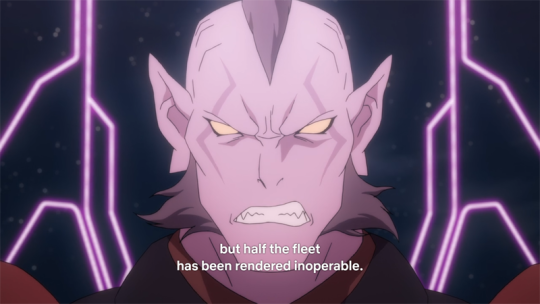
Officer: We’ve suffered little to no casualties, but half the fleet has been rendered inoperable.
They make a point to state that there are little to no casualties. It contrasts the previous season, where we see Keith actually kill several people. Now we’re back to no deaths.
Remember this; I’m going to bring it up again in later reviews.
All in all though, I wouldn't’ really call this a mission liberation. It’s more of a take over.
Warlord Lahn would rather die, either way.
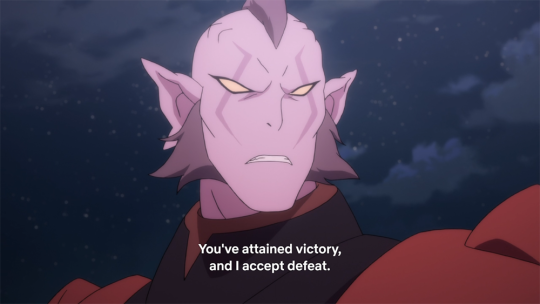
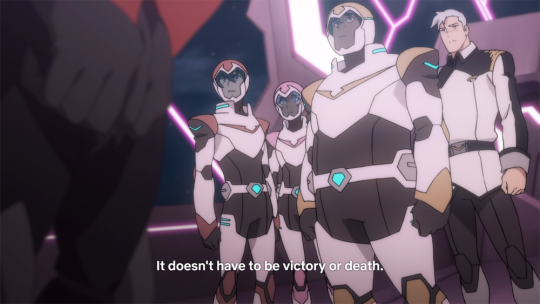
Lahn: You’ve attained victory and I accept defeat.
Keith: It doesn’t have to be victory or death.
Also, I wanna bring up something here.
Lahn makes a dig at Keith (and his mom). Keith’s reaction is important because...there is no reaction. He just takes it.
I bring this up because one of the first complaints I saw about season 8 was that Keith, or even Shiro, didn’t tear this guy a new asshole for his insult.
If you didn’t know, that’s not how you do diplomacy. They just took over his base, let him be upset. A younger Keith might have flown into a rage over this. But he’s much more mature now, and with maturation comes not giving in to the urge to fight at every provocation.
The people who complained about that have obviously never worked retail. You wouldn't last a day.
- - -
So Warlord Lahn's lost fleet comes with a surprise.
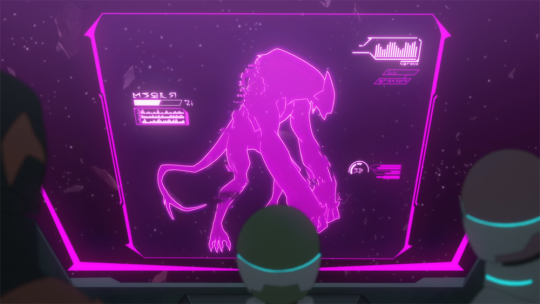
It's...that thing!
I'd forgotten about it. Remember when we were all theorizing what it was?
Well...we still don't really know what it is. But we do get this explanation:
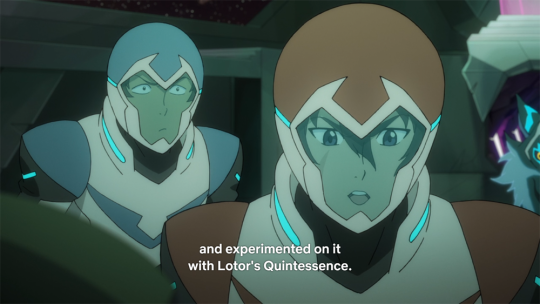


Keith: Ranveig found the creature in the Quantum Abyss and experimented on it with Lotor’s Quintessence. He trained to to take out his Galran enemies, but...
(Lance is very concerned…)
This struck me as odd. It felt as if we were being told information we already knew. Maybe I forgot?
Let's check Season 5, Episode 5.
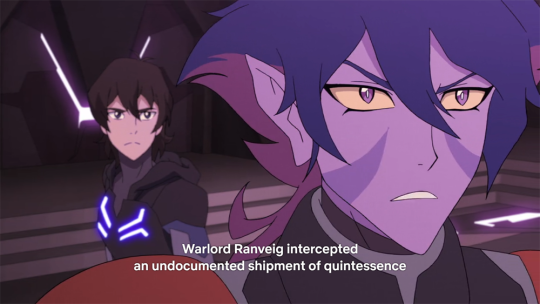
Krolia: Warlord Ranveig intercepted an undocumented shipment of quintessence travelling through his territory. He took it for his own and began experimenting with it. It’s more powerful than any quintessence we’ve received from the empire, and it has some very unexpected effects.
Hmmm….not really.
Also, I miss you, Krolia...
I suppose we can take this as confirmation that Ranveig only considered other Galra his enemies, but it's still a bit off.
Once again, to me it feels as if this is being presented as something we already know, and is just being reviewed. But it’s the first we’ve heard of it, save for Krolia’s very vague explanation transcribed above.
It really makes me believe that they intended to do much more with it. Maybe it was supposed to show up again in seasons 6 or 7, but it was cut out for whatever reason.
It really bums me out. This had potential, and I had been looking forward to it.
- - - -
The episode ends on the best possible note: Lahn accepting the Paladins and joining the coalition. This is in no small part thank to Keith, who very obviously saved him, but also Allura.
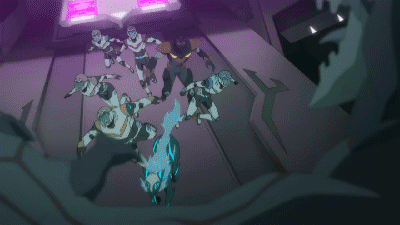
Yoink!
They saved him even though he yelled at them and said mean things. And for that, the Voltron Coalition are one step closer to legitimizing their status as saviors of the universe.
There’s a lesson here: A true display of kindness and patience can change hearts.
In the end, Team Voltron and the Coalition split up, which is what maybe the should have done in the first place, their motivations not being the same at this point.
And so Voltron leaves behind the Atlas, which is the Castleship replacement. The Castleship replacement being the reason they went back to Earth in the first place.
Hm.
-------
And here I have some general positive things, cause that’s my whole M.O.
First, I couldn’t GIF it so you’ll just have to watch for yourself, but Keith’s solo encounter with the creature is beautifully animated. Check out that sexy, sexy frame rate!
Second, Keith gets a boomstick.
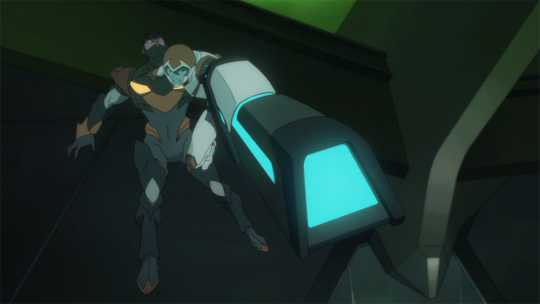
Third, my man Ryan is here.

He doesn’t say anything, but it’s ok, I love him anyway.
And lastly, major props to Ray Chase as Lahn. I never recognize him in anything, and that’s some amazing range.
- - - - -
In summary:
Hey, this ones not so great, I know. Not only did real life get in the way of writing this, I just wasn’t feeling it. I always try to present the facts of the story, then move one to my own thoughts, but dammit...try as I might, I got hung up on one thing and couldn’t really move on from it.
The episode is supposed to be about working through your personal feelings in order to pursue the greater good. It has a second smaller plot of dealing with the creature, and an even smaller point of showing us how the Coalition is running its mission.
But, guys...I don’t like the whole “liberation” thing.
This has everything to do with me and the fact that I came of age during the Bush era “watch out or we’ll bring democracy to your country” mindset. Seeing my faves taking out bases and calling themselves the good guys brought back some thoughts I haven’t had in a long time.
I couldn’t let it go.
So, it’s quite possible this was a well done episode. I just didn’t like watching it. I kinda don’t want to watch it again, either.
I do think that the creature is a big waste of opportunity, though.
So what did you think? Am I out of my mind for feeling like this? I haven’t seen anyone else talk about it, so I’m prepared to be the odd one out here.
Next up:
Pidge has a bad trip.
#second look review#voltron#voltron legendary defender#vld#vld s8#Keith#voltron Keith#Krolia#Allura#Warlord Lahn#Galra#Shiro#voltron Shiro#voltron meta#long post
28 notes
·
View notes
Text
Allura: *Holds the harmonica out* Play it, and you get a 100 million dollars, but 100 million people will die-
Lotor: *Plays the harmonica*
Allura: Lotor no!
#source: vine#voltron incorrect quotes#voltron#i can see this in every iteration#vld#voltron legendary defender#dotu#voltron dotu#80s voltron#voltron defender of the universe#voltron allura#voltron lotor
25 notes
·
View notes
Text
My letter for the @justice-for-allura project. Posting mostly to remind anybody who might be lurking that this is a thing, and it’s a cool thing. If you feel bad bout how Allura’s story went down and wanna make your points known, this is a great opportunity for it.
Edit: Changed some things, fixed a couple typos and reworded some points for clarification.
To the Voltron Team, DreamWorks, to Any and All Involved with the Decision to Kill Off Allura,
Let me begin by thanking the team for giving us this iteration of Allura to begin with. She is a beloved character to many fans. If she wasn’t such a great character, there wouldn’t be so many of us upset about the way her story ended. So, thank you for Allura. She was an amazing character with interesting layers of personality and a delightful design.
In this letter I will explain not only why I was personally disheartened by her death, but also why I believe it was a poor choice to make in terms of writing and the larger narrative.
On the personal end, I related very much to Allura. I empathize with the trauma of losing loved ones and it was cathartic for me to see a character lose so much, but not be defined by that loss. A character who retained a multifaceted personality that included a playful streak, a love of sparkly things, a sense of justice, and abundant courage. She is not reduced to her loss even though it impacts her journey as a character.
Allura’s struggle with Alfor’s corrupted AI also deeply resonated with me. While this is coming from a rather abstract point, it reminds me of my own struggle with a father who is an addict. Allura had to let Alfor’s AI go in spite of how painful it was, in spite of the better memories haunting her every step of the way. The possibility I will have to let my own father go is a very real one because he has made it clear he will never change. His addiction has effectively corrupted our relationship and fed into my own stints with substance abuse. This will be an unspeakably painful decision for me and we have many happier memories that reel through my mind every moment I even contemplate making it.
To relate to a character, to be inspired by a character and her persistence, and then watch her die…really blows. My stomach sank. I felt like crap. I felt even crappier upon hearing that my friend’s nine year old niece sobbed when she watched the ending. I doubt we related to Allura for the same reasons, but I do know that Allura was her favorite character. So with that, I’ll get into the less personal and more objective reasons as to why I feel Allura’s death was a horrible decision.
Firstly, VLD is geared toward younger audiences. I know VLD has a notable periphery demographic, with many older teens and adults such as myself watching and being in the fandom. I know sometimes this periphery demographic can be louder than the intended audience, which I can only assume is children due to the toys and easy-read supplemental materials. VLD has a Y-7 rating, so even if the volume of the periphery demographic drowns out that of the intended, the rating alone demonstrates that this is a show that’s at the least meant to be accessible to children.
Children are impressionable. Representation is important for people of all ages, of course, but it is especially important to children. Kids connect more easily to media where they can see themselves and for the good or the ill, fictional characters can be role models for children.
Allura was a non-white female leader, described in-universe as the “Heart of Voltron.” That’s amazing! That’s truly rare. It’s sad that it’s rare. It’s 2019 and there should be a plethora of non-white female protagonists for young girls of color to look up to. But there aren’t.
Allura was fantastic representation for young girls of color. Representation they hardly ever get. I cannot see a single good reason to take that representation away from them. In fact, it seems downright mean to take that away from them. I do not want the excuse that the staff weren’t aware of the importance of representation, either. You can’t promote the show with official art like this:
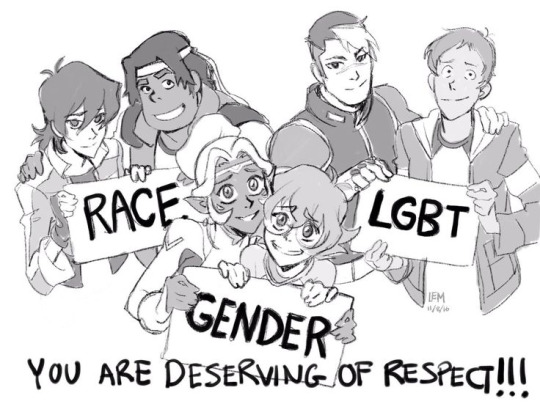
…and claim you’re unaware of how important representation is. Particularly for children, for whom this show was rated as being appropriate for.
I do not feel the excuse that this show was about war is reasonable either. Yes, in real life, war is painful. Lives are lost indiscriminately. This was one of the justifications cited for Adam’s death when VLD was criticized for portraying the “Bury Your Gays” trope. However, VLD had already made it clear that war had costs. The Arusian village was destroyed purposely to bait the team. Several Blades of Marmora lost their lives aiding the team. The costs of war were very clear early on in the show. Allura certainly didn’t have to die to reinforce a theme that had already been reinforced several times prior.
On that note, it is very telling that an apology letter was sent for the death of a character who had all of two minutes of screen time, but not for Allura, a major protagonist.
Many people are offended by Allura’s death, feeling that it is racist and sexist. I do not want to believe that Allura’s death was intended to be either of these things. However, there are serious unfortunate implications in killing off your only WoC in the main cast that cannot be ignored. VLD is fictional but it exists in a real world, where real people are impacted by these issues.
While Allura’s death ultimately feels disrespectful given what she represented and its sheer pointlessness in the story, I see attempts at respect in its overall framing. Allura is revered as a hero. There is a statue built in her honor. She has a legacy. These are things that generally shape the celebration of a fallen hero. But even within the framing, there are mixed signals. Most notably, her loved ones take cheery selfies in font of her monument. In my personal opinion, that is the antithesis to an attempted respectful tone.
And I specifically use the word ‘attempted’ because despite the framing, Allura’s death does not actually come across as respectful in the least. It is crammed into the last nine minutes of the final episode. It is immediately followed by a flash forward to the future. Neither the characters nor the audience have time to mourn her. I do not want to hear the excuse that Allura’s death isn’t offensive because “she died as a hero.” Simply because something may be framed to be respectful doesn’t mean it actually is. The poor execution of that attempted framing itself is one of the lesser of many harmful messages sent by the decision to kill Allura off.
In a world where representation is important, an importance that is acknowledged by the staff, somehow someone still came to the conclusion that Allura’s narrative should end in death. Intent aside, her death falls into the “Disposable Woman” cliche, and is especially gutting because she is a WoC. I cannot reiterate how rare it is to see characters like Allura, non-white women that serve as major protagonists.
Allura suffered unduly throughout the series. She lost an entire planet, her family, her home, her title, and eventually her life. She was always a giving character. She was willing to sacrifice herself to save the Balmera as early as season one. It is noble of her to have that kind of dedication, I’m not saying it isn’t. But girls are socialized to sacrifice their happiness for others, it is a message they internalize at multiple levels.
Girls are socialized to put others before themselves and to sacrifice, and this expectation is especially pressing for girls of color. The SBW (Strong Black Woman) stereotype is a notably prevalent one because of the expectation placed on black women specifically to always be strong and constantly put their own needs last. While Allura is an alien, she is in-universe a minority post Altea’s destruction and IRL, redesigned to be non-white. And many fans, including myself, do see her as specifically black-coded because of her skin tone, hair texture, and having Kimberly Brooks as her voice actress.
A hopeful ending for any character who sacrificed as much as Allura would be one where that character is rewarded for their sacrifice. Where they’re able to find happiness on the other end. Where the audience feels payoff because a character we’ve seen give for so long finally gets. Where the audience feels fulfilled because a character we’ve seen grieve and grieve finally gets to breathe. For kids to see a non-white female character get this kind of ending isn’t only hopeful, but important. Girls— especially girls of color —should be shown that they don’t have to give up everything. Boys should also be shown these narratives, because they shouldn’t internalize the expectation of the girls and women in their lives to constantly sacrifice.
Allura’s sacrifice stands out as particularly glaring when we take into account that teamwork was supposedly one of VLD’s major themes. In a show entitled Voltron: Legendary Defender, wherein the titular robot must be formed by a team, it seems very out of place that it was up to one person to save the day. What was the point of the team bonding with each other, and with the lions, if all of that was going to be rendered useless in the battle that mattered the most?
None of the main characters we’d been led to believe loved each other made any real attempt to find another solution through teamwork. They more or less accepted Allura’s sacrifice at face value even though she was supposedly important to them. The paladins offered some minimal protest, then each gave Allura a hug and just watched her walk to her death. In addition to undercutting the theme of teamwork in the show, it just felt very strange to watch. I didn’t feel like I was watching a team who fought side-by-side at all. These characters felt less connected to each other than they did during the first season and at this point, supposedly they’ve fought side-by-side for years.
Not only did Allura’s lone sacrifice seem to undercut the theme of teamwork, but it just seemed incongruent to the atmosphere of the series. While loss was depicted and prevalent in VLD, nothing ever indicated that it would be a tragedy. Watching Allura’s death play out feels like watching a show that forgot what genre it was supposed to be. The emotional beats aren’t the right ones.
We feel no payoff from her death because it didn’t accomplish anything of value in the narrative. Allura had something to live for after the war, her newfound family and love interest. She didn’t have anything to atone for, unlike Honerva. At best (and I really mean at best here) one could argue that her death contributed to Lance’s development because he spends his life spreading her message after the fact. However, many viewers understandably perceived this as a demotion for Lance with its own set of unfortunate implications. Even if that was the case— which itself feels like grasping at straws for some kind of explanation —I shouldn’t have to point out why it’s extremely problematic for a female character to be killed for her love interest’s development.
Allura’s death felt as pointless as it did out of place. It felt unsatisfying and frankly, just like someone in the writer’s room wanted to be Edgy™ for the sake of it. It also felt particularly mean coming from a team who acknowledged how important representation was to its viewers and who used representation as a promotion point.
VLD is over. That is clear. I do not write this with the intent to get the “real ending” or anything of the like. I write this to express why Allura’s death effected me personally, why I feel it has harmful messages, and why it comes across both as harsh and as poor writing.
I hope all those who were involved with this decision reflect on the feedback from the way her death was perceived, most important the feedback of the WoC in the audience. Major character death should always be handled with care, especially in children’s programs. Representation should always be handled with care, especially in children’s programs. The way Allura’s story ultimately ended feels careless at best and malicious at worst.
Signed,
An Incredibly Disappointed Viewer
61 notes
·
View notes
Note
Is it just me or... was vld.... like, addictive? I consume tons of anime, comics, books, series, movies etc ANYTHING and the last time i felt is was when i was around 14-5 yo with naturo 🤨 2-3(?) years later im still....... holy fuck dare i say UPSET and EMPTY about vld. Is it just me???
Hi, anon, thanks for the note! I’d never interacted with Voltron franchise prior to VLD, but this show really pulled me in too. I had some favorite episodes I would rewatch when I could, and even after all this time, I’m still here writing fanfic for the VLD universe and exploring older Voltron iterations!
I doubt I have an objective perspective to explain “why” VLD was addictive, but I have some personal assumptions:
I think the ATLA-type animation and visual direction was probably the best the franchise has enjoyed so far, and that it represents above-average quality for American-based cartoons. From what I’ve gathered of older iterations, Voltron’s visual quality has been questionable for many years. So it seems like having ATLA-levels of animation and visual design really opened up this old franchise and drew in a much larger fandom per its stronger attention to aesthetics—which ultimately feeds the fanart and fanfic machine. The fact that VLD also injected some visible representation helped to draw in larger crowds. So I really think there’s something important about the visual quality and diversity in cartoons that helps to pull us in and connect with them.
It was a very accessible show in that it was rated Y7 and available to stream, and also was 78 episodes released over the course of a few years. So from 2016-2018, a large potential audience (from young to old) experienced fairly rapid injections of fully animated content to binge.
Between those rapid binge injections, we also had members of the production team creating content and feeding fandom with art, teases, tweets, conventions. VLD also had books and comics published. This created even more of a consistent hype for the show and fed the larger circuit of fandom interactions, theories, other posts, etc. And there’s definitely an addictive, dopamine kick in finding like-minded fans to enjoy a community with.
I think the voice actors significantly enhanced the accessibility of the characters, making memorable characters even more memorable and lovable too.
The sheer expanse of the VLD universe and character cast offered different possibilities and focuses. Voltron franchise isn’t as much of a fandom content generator like Marvel, for example, but VLD universe definitely hit a sweet spot that brought a lot of people together for different reasons, in a pretty short amount of time. We can explore quite a few things in Voltron universe because of just how big it is! Not every franchise has such a breadth of topics and content.
So maybe some of these elements could be things to look for when searching for a new show or story to get lost in? And the VLD show itself, with its mix of space and magic and several possible outcomes, on top of its humor and angst, had a lot of potential. I think the potential of VLD haunts and feeds the fandom, even to this today. Maybe its unrealized potential is why many feel there is a lack of closure too with this show. I know I lean heavily on writing fic to get to ideas or concepts that provide closure for me personally.
With the way the show ended back in 2018, VLD fandom experienced a mass exodus. So it’s possible that it’s not just the show that has left us feeling a bit empty, but simply the realization that the fandom environment changed pretty drastically pretty quickly too.
The good news is that Voltron is a legacy franchise! Many fans remain still, and it’s likely that we’ll see Voltron rise again in some shape or form in the future. Over the course of decades, the Voltron franchise has never truly died.
It’s possible too that maybe a new franchise might still catch your attention in a way you never expect! While VLD is over, I do think it’s good to keep having some optimism for the future—that something will enamor you just as Naruto and VLD did, or that you might at least find peace with your relation to VLD.
Also, there’s nothing wrong with continuing to favor something from the past over something running in the present. I’m still a big Transformers fan even though I’m not active in the fandom for it and have had some disappointments with the franchise. I often rewatch older Transformer shows over quite a few shows running today, lol. That’s the nice thing about fictional content. It lives and stays with you for as long as you want it to.
And who knows? Maybe you’ll even come up with the idea for the next great, addicting franchise!
#Voltron#VLD#Voltron: Legendary Defender#Lightning rambles#VLD and its surrounding environment definitely got to be addicting#It's not just you who feels this way!#I've talked to several who have connected very deeply to this show for one reason or another
28 notes
·
View notes